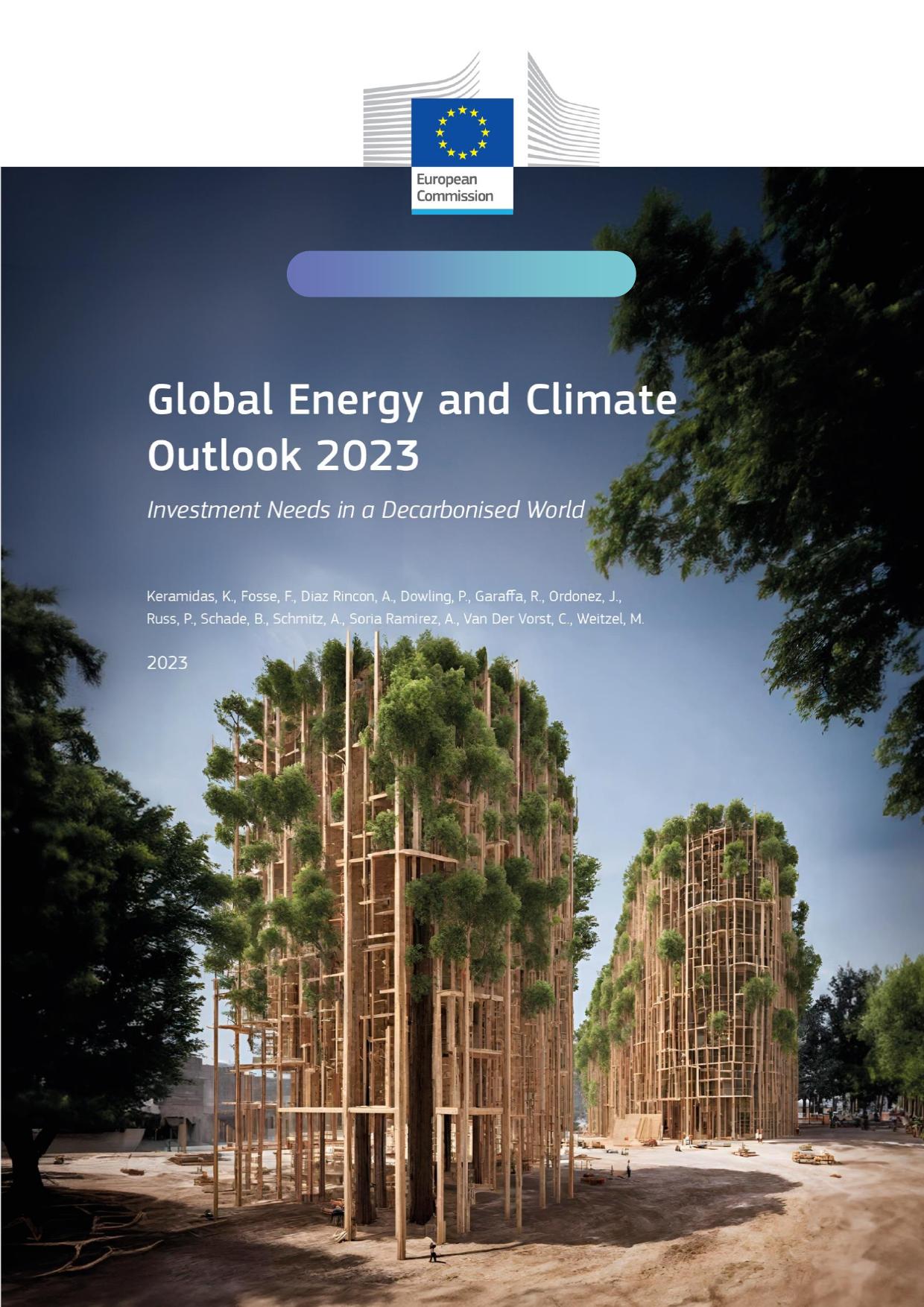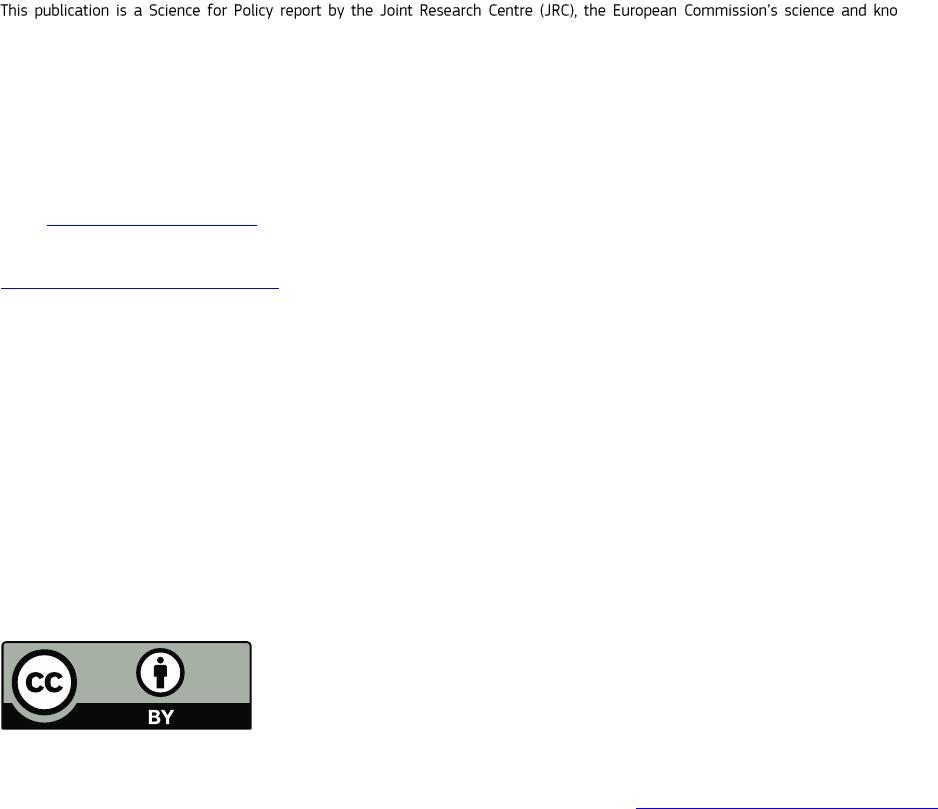ISSN1831-9424JRCSCIENCEFORPOLICYREPORTEUR31792ENwledgeservice.Itaimstoprovideevidence-basedscientificsupporttotheEuropeanpolicymakingprocess.ThecontentsofthispublicationdonotnecessarilyreflectthepositionoropinionoftheEuropeanCommission.NeithertheEuropeanCommissionnoranypersonactingonbehalfoftheCommissionisresponsiblefortheusethatmightbemadeofthispublication.ForinformationonthemethodologyandqualityunderlyingthedatausedinthispublicationforwhichthesourceisneitherEurostatnorotherCommissionservices,usersshouldcontactthereferencedsource.ThedesignationsemployedandthepresentationofmaterialonthemapsdonotimplytheexpressionofanyopinionwhatsoeveronthepartoftheEuropeanUnionconcerningthelegalstatusofanycountry,territory,cityorareaorofitsauthorities,orconcerningthedelimitationofitsfrontiersorboundaries.ContactinformationEmail:JRC-GECOutlook@ec.europa.euEUScienceHubhttps://joint-research-centre.ec.europa.euJRC136265EUR31792ENPDFISBN978-92-68-10948-9ISSN1831-9424doi:10.2760/836798KJ-NA-31-792-EN-NLuxembourg:PublicationsOfficeoftheEuropeanUnion,2023©EuropeanUnion,2023ThereusepolicyoftheEuropeanCommissiondocumentsisimplementedbytheCommissionDecision2011/833/EUof12December2011onthereuseofCommissiondocuments(OJL330,14.12.2011,p.39).Unlessotherwisenoted,thereuseofthisdocumentisauthorisedundertheCreativeCommonsAttribution4.0International(CCBY4.0)licence(https://creativecommons.org/licenses/by/4.0/).Thismeansthatreuseisallowedprovidedappropriatecreditisgivenandanychangesareindicated.ForanyuseorreproductionofphotosorothermaterialthatisnotownedbytheEuropeanUnionpermissionmustbesoughtdirectlyfromthecopyrightholders.TheEuropeanUniondoesnotownthecopyrightinrelationtothefollowingelements:-CoverpageimagecreatedwithCanvaMagicMedia.Howtocitethisreport:Keramidas,K.,Fosse,F.,DiazRincon,A.,Dowling,P.,Garaffa,R.,Ordonez,J.,Russ,P.,Schade,B.,Schmitz,A.,SoriaRamirez,A.,VanDerVorst,C.andWeitzel,M.,GlobalEnergyandClimateOutlook2023,PublicationsOfficeoftheEuropeanUnion,Luxembourg,2023,doi:10.2760/836798,JRC136265.ContentsAbstract.......................................................................................................................................................................................................................................................................1Acknowledgements..........................................................................................................................................................................................................................................2Executivesummary..........................................................................................................................................................................................................................................31Introduction.....................................................................................................................................................................................................................................................62Scenariosanddefinitions..................................................................................................................................................................................................................83Globalemissions,andenergysupplyanddemand...............................................................................................................................................103.1Greenhousegasemissionsandtemperaturechange...........................................................................................................................103.2Energysupplyinthe1.5°Cscenario.......................................................................................................................................................................113.2.1Totalprimaryenergysupply........................................................................................................................................................................113.2.2Powergeneration...................................................................................................................................................................................................133.3Finalenergydemand............................................................................................................................................................................................................133.3.1Industry............................................................................................................................................................................................................................133.3.2Transport........................................................................................................................................................................................................................153.3.3Buildings.........................................................................................................................................................................................................................163.4Globalrenewableandenergyefficiencyindicators................................................................................................................................173.5Fossilfuelsubsidiesphase-out..................................................................................................................................................................................194Energyinvestmentneedsinthe1.5°Cscenario.......................................................................................................................................................214.1Investmentsinenergysupply......................................................................................................................................................................................234.1.1Powergenerationsector.................................................................................................................................................................................244.1.2Potentialstrandedassetsinpowergenerationinthe1.5°Cscenario................................................................254.2Investmentsincleanenergytechnologies.......................................................................................................................................................274.3Supplychainimplicationsofenergyinvestments....................................................................................................................................284.3.1Investmentspilloversandstimulustoothersectors...........................................................................................................294.3.2Employmentshiftsasaresultofadditionalinvestmentdemand.........................................................................325Conclusions..................................................................................................................................................................................................................................................366MajoreconomiesandWorldfactsheets.........................................................................................................................................................................37References.............................................................................................................................................................................................................................................................56Listofabbreviationsanddefinitions...........................................................................................................................................................................................60Listofboxes.........................................................................................................................................................................................................................................................62Listoffigures.....................................................................................................................................................................................................................................................63Listoftables........................................................................................................................................................................................................................................................64Annexes....................................................................................................................................................................................................................................................................65Annex1:DescriptionofPOLES-JRC......................................................................................................................................................................................65Annex2:DescriptionofJRC-GEM-E3..................................................................................................................................................................................72Annex3:Socio-economicassumptionsandfossilfuelprices....................................................................................................................79Annex4:Policiesconsidered.......................................................................................................................................................................................................80iAbstractThiseditionoftheGlobalEnergyandClimateOutlook(GECO2023)presentsanupdatedviewontheimplicationsofenergyandclimatepoliciesworldwidetoreachingthegoalsoftheParisAgreement,andcontributestoJRCworkintheUNFCCCpolicyprocess.Thisreportprovidesinsightintotheinvestmentandrelatednewjobsrequiredbythetransitiontoalow-carboneconomy.Currentclimatepolicypledgesandtargetsimplyarapiddeclineingreenhousegasemissions.Still,thereremainsbothanimplementationgapinadoptingpoliciesalignedwithcountries'mid-termNationallyDeterminedContributionsandLong-TermStrategies,andacollectiveambitiongapinreducingemissionstoreachtheParisAgreementtargetsofpursuingeffortstolimitglobalwarmingto1.5°C.Globalemissionsareprojectedtopeakduringthecurrentdecade,butfailingtoimplementadditionalpoliciesputstheworldonatrajectorytowardsalong-termtemperatureincreaseof3°C.Thecurrentdecadeiskeyforkeepingthe1.5°Ctargetpossible.GECO2023highlightstheglobalinvestmentneedsofthe1.5°Cscenario.Accelerateddecarbonisationeffortsareneededacrossallsectorsoftheeconomy.Energysectorinvestmentsneedtotriplethisdecade,doublingenergyefficiencyratesandbringingrenewablesdeploymentto11TWby2030.Thistransitioncomesalongwithsubstantialinvestmentspill-overandstimuluseffects,boostinginvestmentandemploymentacrossvaluechains,e.g.intheconstructionandelectricalandequipmentgoodsmanufacturing.1AcknowledgementsThisstudywaspreparedbytheEconomicsofClimateChange,EnergyandTransportunit(C6)oftheDirectorateforEnergy,TransportandClimateoftheJointResearchCentre(JRC)oftheEuropeanCommission.ThisreportwasmainlywrittenbyPaulDowling,KimonKeramidas,FlorianFosse,BurkhardSchade,AndreasSchmitz,RafaelGaraffa,CamilleVanDerVorst,JoseOrdonez,MatthiasWeitzel,andAndreaDiazRincon.Theenergyandgreenhousegas(GHG)emissionsmodellingwasperformedbyFlorianFosse,KimonKeramidas,BurkhardSchade,AndreasSchmitzandPeterRuss.TheeconomicmodellingwasperformedbyRafaelGaraffa,JoseOrdonez,CamilleVanDerVorstandMatthiasWeitzel.VisualsandinfographicsincludedinthisreportweredevelopedbyEsperanzaMorenoCruzandVictorianoMadronaldelosSantos.TheGECOwebsitewasdevelopedbyBrunoCattaneoandJuliaGarciaLopez.Thereportbenefittedfromthecomments,contributionandsuggestionsreceivedatvariousstagesofthereport,inparticular,fromcolleaguesfromtheDirectorate-GeneralforClimateAction(DGCLIMA)andDirectorate-GeneralforEnergy(DGENER),andfromJRCcolleagueFrederikNeuwahl.TheexpertcollaborationwiththeCleanEnergyTechnologyObservatory(CETO)providedvaluableinsightsregardingseveralcleanenergytechnologies(CETO,2023).CETOisajointinitiativebetweentheEuropeanDirectorate-GeneralforResearchandInnovation(DGRTD)andDGENER.AuthorsKeramidas,K.,Fosse,F.,DiazRincon,A.,Dowling,P.,Garaffa,R.,Ordonez,J.,Russ,P.,Schade,B.,Schmitz,A.,SoriaRamirez,A.,VanDerVorst,C.,Weitzel,M.2ExecutivesummaryThiseditionoftheGlobalEnergyandClimateOutlook(GECO)presentsanupdatedviewoftheimplicationsofenergyandclimatepoliciesaroundtheworld.Sincethepreviousedition,cleanenergydeploymenthasacceleratedfurther,puttingapeakofglobalemissionswithinreach.Callshavemultipliedformobilisingglobalactiontowardstriplingtheinstalledrenewableenergycapacityto11TWanddoublingtherateofimprovementinenergyefficiencyby2030.Thisreportaimstolookatinvestmentsinenergyproduction,transformation,supplyanddemandandhowtheyneedtopickuppaceduringthecurrentdecadeinordertoaligntheglobaltrajectoryofemissionswitha1.5°C-compatiblepathway,aswellashighlightingimplicationsforemployment.PolicycontextIn2023,theimpactsofclimatechangearealreadybeenfeltwithunprecedentedextremeweathereventsandhottemperatures,showingtheurgencyforactingonclimatemitigationandadaptation.2023hasalsoseenunprecedentedlevelsofinvestmentincleantechnologies.ties(CounciloftheEU,2023a)oftheUnitedNationsFrameworkConventiononClimateChange(UNFCCC),theglobalstocktakeends,lookingbackattheprogressmadecollectivelyinreachingtheobjectivesoftheParisAgreementof2015.Whilstcountrieshavemadeanumberofannouncementsandsetthemselvestargetsforthemediumandlongterm,thecombinedresultrevealsanambitiongapthatasksforadditionaleffort.ThisreportexplorestheeffectsontheenergymarketsofthelatestNationallyDeterminedContributions(NDC),Long-TermStrategies(LTS)andNet-ZeroTargetssubmittedorannouncedinthecontextoftheUNFCCC.Itexamineshowtheenergymixshouldtransformandhowinvestmentsneedtobemobilisedinordertoreachthecollectivegoaloflimitingclimatechangeto1.5°C.KeyconclusionsMeetingthe1.5°CtargetsetoutintheParisAgreementrequiresarapidshifttoenergysystemsdominatedbyrenewablesources.Alongwithenergyefficiencyimprovements,far-reachingelectrificationofend-usesdrivesdowntotalvolumesoffossilfuelextraction.Projectionswithcurrentlegislatedenergy-climatepoliciespointtoglobalemissionspeakingwithinthecurrentdecade,whichisanimportantshiftinexpectationscomparedtoearlieryears.However,thereremainbothasignificantimplementationgaptoreachannouncedtargetsandanambitiongaptoaligntargetswitha1.5°Ctrajectory.Thecurrentdecadeisakeyperiodforacceleratinginvestmentsincleantechnologiesandslashingemissionstokeepthe1.5°Ctargetpossible.Duringthisdecade,globalinvestmentsincleantechnologiesshouldtriple,renewablesdeploymentshouldacceleratetoreach11TWandannualenergyefficiencyimprovementsshoulddouble.MainfindingsGlobalemissionsarestillnotontracktodeliveronthetemperaturetargetsoftheParisAgreement.BoththeReferenceScenario,whichcapturesthecurrentpolicysettings,andtheNDC-LTSScenario,whichcapturesthecurrentannouncedclimatetargetsglobally,fallshortoflimitingtemperatureriseto1.5°C.Progressisbeingmade.Policyactioninmajoreconomies,continuedcostreductionsandaccelerateddeploymentoflow-emissionstechnologiesinthepastyearleadtoemissionsintheReferencescenariopeakingwithinthisdecadeanddecreasingdownto2017levelsby2030,leadingtoa3.0°Ctemperaturechangeby2100.CurrentclimatepolicypledgesandtargetsintheNDC-LTSscenarioimplyarapiddeclineingreenhousegasemissions,butgapsremaininimplementation(8GtCO2ein2030comparedtoReference)andinambition(10GtCO2ein2050comparedto1.5°C).3Figure1:Globalemissionsandglobalmeantemperaturechange,byscenario603.5503.02.540TotalGHGemissions,GtCO2e°C2.030History1.5Ref.20NDC-only1.0NDC-LTS101.5C0.50200020102020203020402050206020702080209021000.0199020202040206020802100-10Source:POLES-JRCmodel;liveMAGICC(probabilisticsetting).Thetemperaturelinesreferto67%probability;therangesrefertothe83%and17%percentileranges.Theovershootinthe1.5°Cscenarioislimitedto1.6°Catmedianprobabilityand1.7°Cat67%probability.Inthe1.5°Cscenario,theshareofrenewablesintotalnewannuallyinstalledcapacityincreasesfrom58%in2021to83%in2030,whiletheshareofnon-renewablesintotalinstalledcapacityhalves.Theworldmustmovequicklyinthecomingdecadetothepointwherethebulkofnewpowergenerationcapacitiesisrenewables.Renewablepowergenerationtechnologiesreach11TWofdeployedcapacityin2030,whiletheannualrateofenergyefficiencyimprovementsmorethandoublesthisdecadecomparedtotheprevious.Afossilfuelsubsidiesphase-outscenario,whichassumesallglobalfossilfuelsubsidiesarecompletelyphasedoutby2025,seessignificantemissionsreductionscomparedtotheReferencescenario,4%in2030and9%in2050.Thiscorrespondstoa13%reductionincumulatedemissionsbytheendofthecentury,leadingtoanend-of-centurytemperatureincreaseof0.2°ClowerthanintheReferencescenario.Togivesomecontexttothemagnitudeofemissionsreductionsinthisscenario,thedecreaseachievedin2030isequivalenttoone-thirdoftheemissionsreductionsintheNDC-onlyscenario,whichisaresultofemissionsreductionsderivedfromtheNationallyDeterminedContributionsof193countries.Keeping1.5°Cpossiblerequiresacceleratingenergy-relatedinvestmentsinthecurrentdecade.Annualspendingonenergyproductionandsupplyequipmentincreasesby70%thisdecade,andalmostdoublestoreach$3.8trillionbythemiddleofthecentury,withaparticularlysharpincreaseinrenewalblepowergenerationinvestmentinthecurrentdecade.Nevertheless,energy-relatedinvestmentasashareofglobalGDPremainsatthehistoricalaverageof1.4%throughtheprojectionperiod.Spendingonbatteriesforelectricvehiclesincreases12-foldto2030,torepresentthelargestinvestmentincleantechnologies.Investmentsintheproductionofhydrogenandhydrogen-derivedfuels(e-fuelsandammonia)representaroundaquarteroftotalcleantechnologiesinvestmentsby2050.Despitetheirminorroleintheaggregatefinalenergyconsumption,thesearecrucialindecarbonisingspecificsectorssuchasaviation,shipping,andsteelproductionandreplacinggreyhydrogeninfertiliserproduction.GECO2023showsthatscalingupinvestmentsincleantechnologiesinlinewitha1.5°Cdecarbonisationtrajectorybearspotentialbenefits,beyonddeliveringtheenergytransitionanditsmultipleenvironmentalandclimatebenefits.Scalingupinvestmentsincleantechnologiescompensatesfordeclininginvestmentsinfossilfuels,boostingdemandforinvestmentacrossdifferentsectorsintheeconomy,suchastheconstructionandmanufacturingsectors.Thedemandforinvestmentalsocreatessubstantialemploymentopportunitiesacrossthevaluechain,asmoreworkersareneeded,bothdirectlyinthesectorsaswellasintheupstreamsectorsthatproducegoodsrequiredfortheenergytransition.4RelatedandfutureJRCworkTheGlobalEnergyandClimateOutlook(GECO)ispublishedannuallysince2015.ItcontributestotheJRCworkintheUNFCCCpolicyprocess,theIPCCAssessmentReportsandtheUNEPEmissionsGapReports.QuickguideAfteranintroductiondescribingthemotivationandscopeoftheGECOthisyear,Section2providesdetailsontheclimatepolicyscenarios,Section3presentskeyresultsforemissionsandenergysystemsonthegloballevel.Section4takesadeepdiveintotheinvestmentneedsinenergysupplyanddemandtomakethetransitionareality.AfinalSectionprovideskeymetricsforG20countries.51IntroductionTheyear2023wasayearofrecords.AccordingtotheWorldMeteorologicalOrganization,2023issettobethewarmestyearonrecord,atabout1.40°C(+/-0.12°C)abovepre-industriallevels(WMO,2023).Extremeweatherevents,suchasheatwaves,droughtsandwildfires,increasedin2023,withtheireconomicimpactroughlyestimatedtoamountto0.6%ofglobalGDP(Allianz,2023),upfromabout0.2%forthe2000-2019period(NewmanandNoy,2023).Thissituationunderscoresthegravityofclimatechangeanditstangibleimpactsonglobalecosystems,humansocieties,andinfrastructure,withclimatescienceexpectinganincreasingfrequencyandintensityofsuchevents.Theurgencywithwhichclimateadaptationandmitigationmeasureshavetobepursuedpresentsanunparalleledchallengeforhumancivilisation.TheParisAgreementobjectivetopursueeffortstolimittemperatureincreaseto1.5°Cisindangerofbecomingimpossible,atleastnotwithoutovershootandlatertemperaturedecreasewithactivecarbondioxideremovalfromtheatmosphere.CO2emissionsarestillrisingandhaveexceededpre-Covid-19levels,withanestimatedincreaseof1%(+/-0.5%)in2023(SandangerandPeters,2023).InternationalfossilfuelninUkrainein2022.However,thelastingimpactsoftheseeventscontinuetoreverberate,underscoringtheneedforresilience-buildingmeasureswithinsupplychainsandenergymarkets.Concurrentwiththis,considerableinvestmentsinfossilfuelinfrastructurearestillhappening.Alargefleetofnewfossilfuelpowerplantsarestillbeingconstructedorplannedover1000GWofcoalandgasprojectsatdifferentstagesfromannouncementtoconstruction(GlobalEnergyMonitor,2023a,2023b)--which,alongwiththeexistingfleet,wgetifoperatedunderbusiness-as-usualconditions.Fossilfuelextractionprojectsalsolargelyexceedtheremainingcarbonbudgetto1.5°C(Kühneetal.,2022).Atthesametime,therearesignsofchange.Investmentsincleantechnologiesarealsobreakingrecordsin2023,withanestimated8-22%increaseover2022(BNEF,2023;IEA,2023a);salesofelectricvehiclesaregrowingfast,with2023salesexpectedtobeabout35%higherthantherecord-breaking2022(IEA,2023b;King,2023).Manytechnologiesareexponentiallygrowing,anticipatinganupcomingtideturnintheenergymix.Policysupport,technologicaldevelopmentandshiftinginvestorpreferencesappeartoalignwithastrengthenedambitiontodeploynewtechnologiesandeffectivelyreduceemissions.Accordingly,globalcleanenergysupplychainsarescalingupandcontributingtoincreasingcollaborationbetweennationsandreducingdependencyonconventionalenergysources.ThisyearseesthefirstglobalstocktakeoftheParisAgreementoftheUNFCCC,aprocessforcountriesandstakeholderstoseewheretheycollectivelystandandhowtheyaremakingprogresstowardsmeetingthegoalsoftheAgreementsince2015.PreviouseditionsoftheGECOreportshavepointedoutthesignificantimplementationandambitiongapsthatremaintobeemissionsandenergymarketsareheading,whatimpactannouncedtargetscanmake,andwhatinvestmentsarerequiredtolimittheglobaltemperatureincreaseto1.5°C.GECO2023firstinvestigateshowpolicies,updatedenergypricesandtechnologycostevolutionswillimpacttheglobalenergysystem;emissionsprojectionsandassociatedtemperatureincreasesarepresentedinthreescenarios(Section3).Thereportthenprovidesadeepdiveintoinvestmentsincleantechnologiesandassociatedsupplychaineffectsincapitalandlabour(Section4).Finally,itpresentsfactsheetswithkeymetricsformajoreconomies(Section6).Box1.DifferenceswithGECO2022ThePOLES-JRCmodelhasbeenupdatedwiththelatesthistoricaldata.Supply-sideanddemand-sidetechnologiescostsaswellaslearningrateswereextensivelyupdatedwithrecentliterature(CETOB2,2024).Fuel/technologypreferenceparameterswererevisedtoreflecttheupdateddata.Thecarbonpriceinthe1.5°Cscenariowasrevisedtoreflecturgentactiontolimittemperatureovershoot;thecarbonpricetrajectoryfollowsasigmoidcurvewithaninflectionpointbefore2030.6HistoricalCO2emissionsfromagriculture,landuse,landusechangeandforestry(AFOLU)arebasedon(Grassietal.,2023)andthusfollowtheconventionsofnationalGHGinventoriestoUNFCCCforallcountries.LandusefluxesprojectionsfollowthesamelogicaspreviousGECOreportsbyreportingchangescomparedtothebaseyear(basedondataprovidedbytheGLOBIOM-G4Mmodels).Forthereportingatthegloballevel,CO2AFOLUemissionswereharmonisedtoglobalbook-keepingmodels,asusedintheSharedSocioeconomicPathways(Riahietal.,2017)andIPCCAR6WGIII(IntergovernmentalPanelonClimateChange(IPCC),2023),throughaconstantadjustmenttomatch2015emissionsofCMIP6.Inotherstudiesthisadjustmentisvariable,tryingtotakeintoaccounttheexpectedimpactoftheCO2fertilisationeffectonthefuturestrengthofthelandsink(Grassietal.,2021,Giddenetal.,2023),whichinfluencesthefuturenetglobalanthropogenicemissionsandtheremainingcarbonbudget.TheJRC-GEM-E3wasmodifiedtoincludeaninvestmentmatrixwhichcreatesadirectlinkbetweeninvestingsectorsandsectorssupplyingthepurchasedinvestmentgoods(Normanetal.,2023).Thiscapturesheterogeneityacrossinvestingsectors,inparticularpowergenerationtechnologies.Atalltimes,monetaryvalues($)areconstantUSdollarsof2022.Theresultsinthisreportdonotprejudgetheupcomingresultsofthe2040ClimateTargetFramework.72ScenariosanddefinitionsGECO2023wasproducedbasedonresultsfromthepartialequilibriumglobalenergymodelPOLES-JRCandthegeneralequilibriummodelJRC-GEM-E3thatcoverstheinteractionsbetweentheglobaleconomy,theenergysystemandtheenvironment.AdescriptionofthePOLES-JRCmodelusedinGECO2023canbefoundinAnnex1,andtheJRC-GEM-E3modeldescriptionisinAnnex2.Inaddition,detailonsocio-economicassumptionsandfossilfuelpricescanbefoundinAnnex3.Thissectionprovidesadescriptionoftheassumptionsmadefortheprojectionspresentedinthisreport.Thefollowingscenariosweremodelled:Referencescenario:correspondstoaworldwhereexistingpoliciesrelatedtoenergysupplyanddemandpoliciesandtargets,aswellaslegislatedGHGpoliciesandtargetsthatarebackedbyconcretesupportingenergy-sectorpolicies,areenacted.NoadditionalpoliciesareconsideredcomparedtowhathadbeenlegislatedasofJune2023.Exogenousmacroeconomicprojections(GDPandpopulation),withendogenouslycalculatedenergypricesandtechnologicaldevelopmentspecifictothePOLES-JRCmodel,togetherwiththeeffectofenactedpolicies,resultinprojectionsoftheenergysystemandGHGemissions.Asaconsequence,thisscenariomaydifferfromenergyandemissionsprojectionsfromofficialnationalsourcesandinternationalorganisations.SeeAnnex4forthelistofpoliciesconsideredintheReferencescenario.Thisscenariodoesnotaimtoreachstatedpoliciesortargets,whetherlegislatedornot,thathavenotbeenaccompaniedbyconcreteactionplans.AFossilfuelssubsidiesphase-outscenariowasalsomodelled,startingfromtheReferencescenarioandassumingatotalphase-outofexplicitandimplicitsubsidiesin2025,toassesstheimpactofoneofthemainCOP28topics.Themethodologyandresultsarediscussedinthededicatedsection3.5.NDC-LTSscenario:considersthetargetsofNDCsinthemediumtermandtheLTSsinthelongerterm.ThisscenarioassumesthattheobjectivesintheNDCs(includingconditionalobjectives)arereachedintheirrelevanttargetyear(2030inmostcases).Tothisend,carbonvaluesandotherregulatoryinstrumentsareputinplaceontopoftheexisting,legislatedmeasuresoftheReferencescenariotoreachsector-specificoreconomy-widetargetscountryhasnotannouncedanLTS,itisassumedthatnoadditionaldecarbonisationeffortismade,andcarbonvalues,ifany,arekeptconstanttotheir2030level.Thisscenarioincludesthenetzerotargetsannouncedbymanycountries.TheNDC-LTSscenarioalsoconsidersdecarbonisationproposalsrelatedtointernationalaviationandmaritimetransportationsectors.SeeAnnex4foralistofNDCandLTSobjectivesincludedinthisscenario.projectionsdifferfromnationalmodellingexercisesintheNDCs,mostlyduetodifferentkeymacroeconomicassumptionsandconsequentlyenergydemandgrowth,butalsooperatingpatternsofthepowersector.ThiscanleadtosomesectoraltargetsinanNDCnotbeingreachedintheNDC-LTSscenario;however,efforthasbeenmadetoachievethemostimportanttargetsregardingrenewablesandemissionsreductions.AnNDC-Onlycasewasalsomodelled,wheretheeffectoftheLTSswasremovedfromtheNDC-LTSscenarioinordertoquantifytheimpactofeachmechanism;carbonpricesoftheNDC-LTSscenario,ifany,werekeptconstantafter2030intheNDC-Onlycase.1.5°Cscenario:thisscenarioisdesignedtolimitglobaltemperatureincreaseoverthecenturyto1.5°Cattheendofthecenturyandlimitovershootof1.5°Cintheinterveningdecades.Inthisscenario,theglobalcarbonbudget(cumulatednetCO2emissions)from2020untiltheyearwhennet-zeroCO2emissionsarereachedisofapproximately530GtCO2.Alongwithnon-CO2emissionsandairpollutantemissionsprojections,thisresultsinanapproximately77%probabilityofnotexceedingthe1.5°Ctemperaturelimitin21001.Asingleglobalcarbonpriceforallregionsisusedinthisscenario,startingimmediately(2024)andstronglyincreasing.Bottom-uppolicydrivers(suchasrenewablestargets)fromtheNDC-LTSscenarioarenotincludedhere,asthisscenarioisconstructedbasedonthepolicysettingsoftheReferencescenario.Theglobalcarbon1GlobalmeansurfacetemperaturesobtainedwiththeonlinetoolliveMAGICC,basedonGHGandairpollutantemissionsprojectionsfromPOLES-JRC(LiveMAGICC,2023).77%probabilityderivedasalinearinterpolationbetweentheprovidedprobabilitiesof67%and83%.8priceisthesoleadditionalpolicydriverinthisscenario.Thisscenarioisthereforeastylisedrepresentationsofaneconomically-efficientpathwaytothetemperaturetargets,astheuniformglobalcarbonpriceensuresthatemissionsarereducedwhereabatementcostsarelowest.Thisscenariodoesnotconsiderfinancialtransfersbetweencountriestoimplementmitigationmeasures.Theuseofnegativeemissionstechnologies,includingthelandusesinks,isconsiderable(26GtCO2/yearin2100,includingCO2capturedfortheproductionofsyntheticfuels);CO2capturefromcombustionandCO2directaircapturetechnologiesaremadeavailableprogressivelybeyond2030(<10GtCO2/yearin2050).Themobilisationofbiomassasanenergyresourceisrelativelylimited(remainingbelow200EJ/yearforallyears),inordertoreflecttheuseofonlysustainably-grownbiomass2.Withintheaboveeconomicandtechnologicalconstraints,theovershootofthetemperaturetargetwaskeptlow(withapeaktemperatureat1.6°Cin2050,atmedianprobability).Unlessstatedotherwise,allmonetaryvaluesinthisreportarein2022USD.2Thereappearstobeamoderateagreementintheliteratureforthepotentialofbiomassforenergyuseofabout200EJ/year,andahigherlevelofagreementforthemoreconventionalfigureof90EJ/year(Creutzigetal.,2015).93Globalemissions,andenergysupplyanddemand3.1GreenhousegasemissionsandtemperaturechangeDespitethecontinueddeploymentofrenewables,electricvehicles(EVs)andotherlow-emissiontechnologies,globalemissionsintheReferencescenarioarebroadlyinlinewiththosepresentedinGECO2022,reachingapproximately50GtCO2eqbythemiddleofthecentury.TheReferencescenarioresultsinanend-of-centurytemperatureriseof3.0°Cata67%probability.However,progressisbeingmadeasglobalemissionsareprojectedtopeakinthemiddleofthisdecadeanddecreasingdownto2017levelsby2030.Whilethepost-Covid-19economicrecoverywasslightlyfasterthanexpected3,longer-termprojectionsareofanoverallslowereconomicgrowth4.Asaconsequence,totalglobalGDP(inPPPterms)isprojectedtobeFigure2:Globalemissionsandglobalmeantemperaturechange,byscenario603.53.0502.52.0401.5TotalGHGemissions,GtCO2e1.0°C0.5300.0History20202040206020802100Ref.20NDC-onlyNDC-LTS101.5C0200020102020203020402050206020702080209021001990-10Source:POLES-JRCmodel;liveMAGICC(probabilisticsetting).Thetemperaturelinesreferto67%probability;therangesrefertothe83%and17%percentileranges.Theovershootinthe1.5°Cscenarioislimitedto1.6°C(medianprobability).End-of-centuryvaluesformedianprobabilityare:2.7°CforReference;2.2°CforNDC-only;1.7°CforNDC-LTS;and1.2°Cfor1.5°C.TheNDC-LTSscenarioshowsthatifallpledgesarefullyachieved,theresultingtemperaturerisebytheendofthecenturyis1.9°C(67%probability),indicatingthatmoreeffortonbothimplementationandambitionarerequired.TheNDC-onlycase,whichshowstheresultofthesubmittednationally-determinedcontributionsandexcludestheimpactofcountrieslong-termstrategies,whicharemostlynetzerotargets,seesemissionsstabilisepost2050andleadstoatemperatureincreaseof2.5°C(67%probability)bytheendofthecentury.The1.5°Cscenarioseesnetzeroemissionsgloballyachievedbefore2070,andovershootlimitedto1.6°C.3+0.2%/yearGDPgrowthin2022-2023comparedtolastye.4-0.2%/yearGDPgrowthover2024-2040,-0.3%/yearover2041-2070and-0.2%/yearover2071-2100estimates.10Figure3:Globalemissions,bysector,1.5°CScenario605040GtCO2e302010020102020203020402050206020702080209021002000BuildingsTransportIndustrialprocessesOtherIndustry(combustion)PowerLULUCF-10AgricultureSource:POLES-JRCmodel.Otherincludesnon-CO2emissionsinenergy,emissionsfromotherenergytransformation(biofuelsproduction,hydrogenandderivedfuelsproduction)aswellasthesinkfromthedirectaircaptureofCO2.Breakingdownthe1.5°Cscenariopathwaybysectorhighlightswhereandwheneffortneedstobefocussed:—Significantratesofemissionreductionsoccurinpowergeneration,transport,buildingsandindustryinthisdecadeandthenextoneinordertoputtheworldona1.5°Ctrajectory.Transport,buildingsandindustry(combustion)reachunprecedentedratesofemissionreduction,around10%onaverageannuallyinthe2030-2040decade.Thepowersectorseesasustained7%reductionannuallyinthecurrentandcomingdecadesandasharpdecline(15%)inthe2040-2050decade.—Carboncaptureandsequestration(CCS)contributestodecreasingemissionsandleadstonet-negativeemissionsinthepowersector,industry(mainlyincementproduction),anddirectaircapture(wheretheCO2thatisnotusedtoproducehydrogen-derivedfuelsissequestered),after2050.—TheLULUCFsectorseessharpemissionreductionsoccurringalmostimmediately,andturnsfromasourcetoanetsinkofemissionspost2030.Afterthatdate,reforestation,afforestationandbetterlandmanagementpracticesarerequiredforthelandsectortobecomeasignificantsinkofemissionsthroughoutthecentury.3.2Energysupplyinthe1.5°Cscenario3.2.1TotalprimaryenergysupplyInthe1.5°Cscenario,therapiddecarbonisationleadstoatransformationoftheprimaryenergysupply:—Theprimaryenergysupplyfromallfossilenergycarriers(coal,oil,andgas)declinesthroughto2050.Theenergysuppliedfromcoalhalvesinthisdecadeandthenhalvesagainbetween2030and2050,toreach0.9Gtoein2050.Primaryoilsupplydeclinesto1.0Gtoein2050,fallingatanaverageof7%annuallyinthe2030-2040decade.Theenergysupplyfromgaspresentsaslightbutsustainedreductioninthecomingdecades,decliningfrom3.5Gtoein2020to1.6Gtoein2050.Unlikecoalandoil,gasstillrepresentsmorethan10%ofthetotalprimaryenergysupplyin2050.—Areductioninenergydemandthisdecadeoccursasaresultofrapidelectrificationinthe1.5°Cscenario,andhigherenergypricesinthisscenario.—Energysupplyfromsolarandwindcontinuestoexpand,butataslowerrateovertheprojectionperiodthantoday.Theremarkableexpansionofthecurrentdecade,withanaverageannualgrowthrateof20%forsolarand18%forwind,decreasesto5%annuallyeachinthe2030-2040decade.Together,windandsolarrepresentaround37%oftotalprimaryenergysupplyin2050.1110-2014Gtoe20-301230-4010202040-5020308204010-206205020-30430-402Gtoe40-500202010-20Totalprimary203020-30energysupply204030-4010%205040-500%202010-20203020-30-10%204030-40205040-5020%Figure4:Globaltotalprimaryenergysupplybyfuel,anddecadalgrowthrates,1.5°Cscenario10%202010-2020304.520-300%20404.030-40-10%20503.540-503.0Coal20202.510-2020302.0Source:POLES-JRCmodel.Notes:OtherRES:geothermalandocean20-30Oil20401.530-4020501.040-50Gas0.520200.01210-20NuclearBiomass203020-30204030-40Hydro205040-50Wind202010-20203020-30SolarOtherRES204030-40205040-50202010-20203020-30204030-40205040-50202010-20203020-30204030-40205040-502020203020402050—Stronggrowthinbiomassseesitdoublingitssupplyinthecomingtwodecades,from1.5Gtoein2020to3.2Gtoein2050.Hydroelectricitygrowthlevelsoffafter2030,whileotherrenewables,geothermalandocean,growatahighratebutfromrelativelylowlevels.—Nuclearseessteadygrowththroughouttheprojectionperiod,from0.2to0.5Gtoe,atapproximately3%annually.3.2.2PowergenerationInthe1.5°Cscenario,totalpowergenerationincreases2.5timesbetween2020and2050.Thisincreaseisaccompaniedbyatransformationthatleadstoseveralstrikingresultsinindividualtechnologies:—Thetransformativeexpansioninsolarandwind:thesetwotechnologiescombinedincreasefrom9%oftotalgenerationin2020to37%in2030and62%in2050.Thisimpliesafive-foldincreasefrom2020to2030,withanaverageannualgrowthrateof16%forwindand21%forsolarinthisdecade.Otherrenewables,mostlyhydroandgeothermal,increasemarkedly,takingoffin2030.—Theretirementofcoal:atthesametimethatrenewablesareintroducedatincreasingspeed,coalgenerationdecreasesatanaverageof11%annuallyinthecurrentdecadeandaround4%after2030.CoalfittedwithCCSplaysaminorrole,reaching0.3%ofpowergenerationin2050.—Fossilgasgenerationisstableinthecomingdecadeandthenslightlydecreasesstartingin2040.Thedispatchabilityofgasprovidesrenewablesbalancingservicesinthenextdecade;beyondthat,gasstartstoretireasbatteriestakeoverwithemissions-freebalancing.GasplantsfittedwithCCSalsoplayonlyaminorrole,reaching0.4%ofpowergenerationin2050.—Biomassgenerationdoublesby2030andseesasix-foldincreaseby2040,mostlytoprovidenet-negativeemissionsthroughbioenergywithCCS(BECCS).—Nuclearcapacityexperiencesacomparablymodestgrowth,almostdoublingby2050asanimportantsourceofzero-emissionselectricity,particularlyincountrieswithanexistingnuclearindustryandthosewithrelativelymorelimitedrenewablesresources.3.3Finalenergydemand3.3.1IndustryDecarbonisationinthe1.5°Cscenarioseestheindustrysectorchangefromonewithadiversifiedenergymixtodaytoonethatisdominatedbyelectricityin2050:—Totalindustrialenergydemandremainsstablethroughto2050,assignificantelectrificationimprovesenergyefficiencyandoffsetsincreasesfromagrowingindustrialoutput.—Electricityincreasesitsshareoftotalindustrialenergydemandfromapproximatelyonequarterto58%in2050(excludingnon-energyusesinindustry),atamodestgrowthrateof2%perannum,asanincreasingrangeofapplicationsareelectrified.—Theshareofcoalinfinalenergydemanddecreasesfromapproximatelyonethirdtodayto5%by2050,asmanyapplicationsswitchtoelectricityuse.Gasdemandremainsmorerobust,morethanhalvingfromtodayto2050,asitisusedinbothenergyandnon-energyapplications(feedstock).—Otherfuelsplaynicheroles,includinghydrogenande-fuels,whichbothrepresentacombinedshareof8%oftotalindustrialdemandin2050.—Biomassdoublesitssharefrom8%todayto15%in2050.13Totalpower020PWh30406070generation5PWh20Source:POLES-JRCmodel.Notes:Fossil-CCS:Coal-CCSandGas-CCS;Biomass:BiomassandBiomass-CCS;OtherRES:geothermalandocean.10-2010%202020-302030105030-405%204040-5020500%10-20202020-30-5%203030-40204040-50-10%205010-20-20%-10%0%10%20%30%40%2020010152520-30203030-40Coal2040Figure5:Globalpowergenerationbytechnology,anddecadalgrowthrates,1.5°Cscenario40-502050Oil10-2020201420-30GasFossil-CCSNuclearBiomassHydro203030-40204040-50Wind205010-20SolarOtherRES202020-30203030-40204040-50205010-20202020-30203030-40204040-50205010-20202020-30203030-40204040-50205010-20202020-30203030-40204040-50205010-20202020-30203030-40204040-50205010-20202020-30203030-40204040-50205010-20202020-30203030-40204040-5020503500Figure6:Globalindustryenergydemandbyfuel,anddecadalgrowthrates,1.5°Cscenario300020002500150020001000150050010000Mtoe50002020203020402050Mtoe2020203020402050202020302040205020202030204020502020203020402050202020302040205020202030204020502020203020402050TotalenergyCoalOilGasBiomassH2E-fuelsElectricity10%demand20%10%0%0%-10%-10%10-2020-3030-4040-5010-2020-3030-4040-5010-2020-3030-4040-5010-2020-3030-4040-5010-2020-3030-4040-5010-2020-3030-4040-5010-2020-3030-4040-5010-2020-3030-4040-50Source:POLES-JRCmodel3.3.2TransportIntheoppositetrendfromthatseeninindustry,thetransportsectortransformsfromonedominatedbyonefueltoday,oil,toamorediversifiedfuelmixby2050.Oildemandrapidlydiminishesasdecarbonisationpushestowardsfirstacceleratingelectricitydemandandthentakinguphydrogenande-fuelsafter2040.—Oildemandstartstoreduceimmediatelyinthe1.5°Cscenario,drivenbytherapidexpansionofEVs.Thecurrentandnextdecadesseethemostsignificantdecreaseinoilconsumptionintransport,withanaverageannualdeclineof6%and11%ineachdecade.—Atthesametime,electricityuseexpandswithanaverageannualgrowthrateof25%and12%inthecurrentandnextdecades.Thegreaterenergyefficiencyofelectrifiedtransportleadstoareductionintotaltransportenergydemandovertime.By2050,electricityaccountsforaroundhalfofthefinalenergydemandintransport.—Hydrogenande-fuelsstarttoplayaroleinheavytransport,aviationandmaritimepost-2040,withannualgrowthratesbetween10-15%.By2050,thesetwoenergyvectorscombinedmeetarounda—Biofuelsuseexpands,butnotasdramaticallyastheabove.Theydoubleinvolumeby2050andincreasetheirsharefrom4%todayto8%by2050.15Mtoe2500Figure7:Globaltransportenergydemandbyfuel,anddecadalgrowthrates,1.5°CscenarioMtoe200020001500150010001000500500002020203020402050202020302040205020202030204020502020203020402050202020302040205020202030204020502020203020402050TotalenergyOilGasBiofuelsH2E-fuelsElectricity10%demand130%100%70%0%40%10%-10%-20%10-2020-3030-4040-5010-2020-3030-4040-5010-2020-3030-4040-5010-2020-3030-4040-5010-2020-3030-4040-5010-2020-3030-4040-5010-2020-3030-4040-50Source:POLES-JRCmodel3.3.3BuildingsSimilartotheotherend-usesectors,thebuildingssectorundergoessignificantdecarbonisationinthe1.5°Cscenario,mostlyviaelectrification:—Attheannualaveragegrowthrateof2.6%,electricityincreasesitsshareoftotalbuildingsenergydemandfrom37%todayto86%by2050.—Thedominanceofelectricitycomesattheexpenseofoilandgaswhichreduceat11%foroiland15%forgasinthe2030-2040decade.—Whiletraditionalusesofbiomassarephasedout,thereisatransientroleformodernformsofbiomassasasubstituteforfossilheatingsystems;however,modernformsofbiomassalsodecreaseafter2030.—Thereisnosignificantroleforhydrogenande-fuelsinthebuildingsectorinthe1.5°Cscenario,remainingbelow20Mtoethrough2050.163000MtoeFigure8:Globalbuildingsenergydemandbyfuel,anddecadalgrowthrates,1.5°Cscenario2500Mtoe250020002000150015001000100050050000202020302040205020202030204020502020203020402050202020302040205020202030204020502020203020402050TotalenergyCoalOilGasBiomassElectricity10%demand5%0%-5%0%-10%-15%-10%-20%10-2020-3030-4040-5010-2020-3030-4040-5010-2020-3030-4040-5010-2020-3030-4040-5010-2020-3030-4040-5010-2020-3030-4040-50Source:POLES-JRCmodel3.4GlobalrenewableandenergyefficiencyindicatorsInrecentmonths,internationaldiscussionstookplaceinthecontextoftheG20worksabouttheneedtoaccelerateclimateprotectiontargets.Inthisregard,theG20membershavepromisedintheNewDelhiDeclarationinSeptember2023topursueandencourageeffortstowardsincreasedglobalrenewables(RE)andenergyefficiency(EE)targetseasingtheenergytransitionatgloballevel(G20,2030).Thesetargetswereendorsed(CounciloftheEU,2023b)andwerelaidoutasaGlobalPledgebythePresidentoftheEuropeanCommissioninCOP28(EuropeanCommission,2023).Theyhavebeenquantifiedas:—11TWofinstalledrenewableenergypowergenerationby2030globally(COP28President-Designate,2023),representingatriplingofinstalledcapacity(IEA,2023c;IRENA,2023).—Doublingannualenergyefficiencyimprovementsgloballyfromabout2%toover4%by20305.Thescenariosinthisreportcanbeusedtoillustratehowthesetargetsareapproximatedormet.IndicatorsofthesetwotargetsarerepresentedinFigure9andFigure10forthethreemainscenariosofthisreport.The1.5°Cscenarioseestheglobalinstalledcapacityofrenewablesincreasefrom3TWin2021to11TWin2030(comprisingofrenewablesinpowergenerationforfinalelectricitydemand,forhydrogenproductionandfordirectaircaptureofCO2).TheNDC-LTSscenarioreaches9TWin2030,indicatingthatmanycountrieshavethepossibilitytoincreasetheircurrentrenewablesplanstocontributetotheglobaltarget.Theshareofrenewablesintotalnewannuallyinstalledcapacityincreasesfrom58%in2021to83%in2030inthe1.5°Cscenario,indicatingthattheworldmustmovequicklyinthecomingdecadetothepointwherethebulkofnewgenerationisrenewable.Theinverseisalsotrue,astheshareofnon-renewablesintotalinstalledcapacityin2030ishalfofthatin2021inthe1.5°Cscenario.17Figure9:Powerindicators-1.5°C,NDC-LTSandReferencescenariosRenewablecapacityShareofrenewableShareoffossilfuelsintotal12additions10100%100%capacity880%80%6x1.4TW4x360%2203060%0202140%40%x-0.520%20%0%20300%2030202120211.5CNDC-LTSRef.1.5CNDC-LTSRef.1.5CNDC-LTSRef.Source:POLES-JRCmodelThe1.5°Cscenarioseesthefinalenergyefficiencyimprovementrate6morethandoublingby2030comparedtothepreviousdecade,i.e.theevolutionover2020-2030comparedto2010-2020.Lookingattheend-usesub-sectorsshowsdiversepatterns.Theimprovementinenergyefficiencyintheindustrysector7,whichwaslimiteduntilrecently,issettoincreaseinallscenarios,showingamorethantwo-foldincreaseinthe1.5°Cscenarioandreflectingarelativelylargeuntappedpotential.Energyefficiencyimprovementsintransport8haveacceleratedrecentlygiventheincreasingpenetrationofelectricvehicles;accordingly,theReferencescenarioshowsahighlevelofimprovementalready,withfurtheraccelerationinthe1.5°C.Likewise,thebuildingssector9morethandoublecomparedtohistoricallevelsby2030,mostlyduetoelectrification.6CalculatedastheannualevolutionoftheratiooftotalfinalenergyconsumptionoverGDP.TheimprovementrateoftotalprimaryenergyconsumptionoverGDPyieldsasimilardoublingby2030.7Calculatedastheannualevolutionoftheratioofsectoralfinalenergyconsumptionoverindustryvalueadded.8Calculatedastheannualevolutionoftheratioofsectoral-kilometres.9Calculatedastheannualevolutionoftheratioofsectoralfinalenergyconsumptionoverfloorsurfaceofresidentialandservices.18Figure10:Globalfinalenergyefficiencyindicators,1.5°C,NDC-LTSandReferencescenariosSource:POLES-JRCmodel.Note:thesegraphsshowtherateofenergyefficiencyimprovementsinend-usesectors,the10-20valueshowstheaverageratefrom2010-2020,the20-valueshowstheratefrom2020-2030.Therenewableandenergyefficiencytargetsbeingdiscussedareintertwined,ashittingtheglobalefficiencytargetwilllikelyrequireincreasedelectrification,thusleadingtoincreasedneedfornewelectricitycapacitymostofwhichisrenewable.Likewise,furtherpenetrationofrenewablepowergenerationcapacitycanleadtolowerelectricityprices,thusimprovingtheeconomicsofelectricity-consumingend-useequipmentwhichareoftenconsiderablymoreenergyefficientthanfossilfuelalternatives.Achievingonetargetfacilitatestheachievementoftheother,thereforejustifyingtheircontinueddiscussionofapairoftargetstobepursuedinparallel.3.5Fossilfuelsubsidiesphase-outDiscussionontheimportanceofphasingoutfossilfuelsfeaturedprominentlyatCOP28.Theexplicitsubsidiestofossilfuelssetanewrecordin2022(reachingUSD1.3trillion);togetherwithindirectsubsidies,totalsubsidiesamountedtoUSD7trillion(IMF,2023a).Commitmentsagreedbycountriesinthepastfewyearstodecreasefossilfuelssupporthavebeenfollowedbyfewconcreteactions.InNovember2023,inthelead-uptoCOP28,theMembersoftheEuropeanParliamentvotedinfavourofendingallimplicitandexplicitsubsidies(EuropeanParliament,2023).Anadditionalscenario,notreportedinSection3.1,isreportedheretoindicatetheimportantimpactthatfossilfuelsubsidyphaseoutcanhaveonglobalemissions.InPOLES,energysubsidiesarecalculatedwithaprice-gapapproachbetweensectoralend-usepricesandreferenceprices(whicharetheimportpriceforimportingcountries,theexportpriceforexportingcountries,ortheclosestregionalmarketpricewhentheformerareunavailable;andareincreasedbyacostoffueldistributionandvalue-addedtax).Thisapproachcoversimplicitandexplicitsubsidies.Subsidisedsectoralpricesarethusaffectedbychangesintheinternationalpricesproportionallytotheirsituationinthelasthistoricalstatistics.Ifthatratiorevealsasubsidy,itiskeptintheprojectionsoftheReferencescenario.Inthesubsidiesphase-outscenario,fortheapplicablesectors,thatratiomovesto1in2025;thisresultsinallglobalfossilfuelsubsidiescompletelyphasedoutby2025.ThisscenarioleadstosignificantsizeablegreenhousegasesemissionsreductionsatthegloballevelcomparedtotheReferencescenario(Figure11).Totalemissionsare2.4GtCO2elowerin2030(a5%reduction)and4.6GtCO2elowerin2050(a9%reduction),similartofindingsinliterature(Jewelletal.,2018;Kitousetal.,2016).Thiscorrespondstoa13%reductionincumulatedCO2emissions(allsectors)bytheendofthecentury,whichleadstotheend-of-centurytemperatureincreasebeing0.2°ClowerthanintheReferencescenario.Upto6%decreaseinprimaryenergydemandisobservedthroughthecentury,reachinga21%reductionoffossilfuelssupplyin2100(Table1).19Togivesomecontexttothemagnitudeofimpactofthefossilfuelsubsidiesphase-outscenario,theemissionsreductionsachievedin2030areequivalenttoone-thirdofthereductionsintheNDC-onlyscenario,whichisaresultofemissionsreductionsderivedfromtheNationallyDeterminedContributionsof193countries(Figure11).Figure11:GlobalGHGemissions,byscenarioSource:POLES-JRCmodel.Themostsignificantemissionsimpactofthesubsidyremovalisseeninpowersectordecarbonisation,wheretechnologiespresentmoreandcheaperoptionsthaninothersectors.Theglobalpowersectorwouldindeedforeseesubstantialemissionsreductionsofmorethan25%in2050(Table1).Table1:Fossilfuelsubsidyphase-outscenarioresultscomparedtotheReferencescenarioYear203020502100Emissionsreduction:allGHGs-4.5%-9.4%-11.6%Emissionsreduction:CO2-energy-7.1%-15.5%-19.4%Emissionsreduction:CO2frompowergeneration-13.3%-25.2%-30.7%Primaryenergydemand-4.2%-6.3%-5.8%Fossilfuelsprimaryenergydemand-7.0%-14.2%-20.9%Source:POLES-JRCmodel.Inaddition,thisleadstoareductioninelectricitygenerationcurrentelectricityproduction),mainlyduetoelectricitydemandreductioninbuildingsandnon-energy-intensiveindustry.Interestingly,thisscenariowouldrequirean8%increaseincumulatedinvestmentsinelectricityandhydrogenproductionby2100,butalsoa6%decreaseinfossilfuelsextractioninvestments.204Energyinvestmentneedsinthe1.5°CscenarioInvestment10canpromoteeconomicgrowthbyincreasingthecapitalstockandtheproductivecapacityoftheeconomyand,therefore,itsaggregateincome.Whiletheshareoftotalinvestmentintheeconomytypicallyvariesbycountry,ithistoricallylieswithintherangebetween15%and25%asapercentageofGDPinadvancedeconomies(e.g.,in2022,25%ofGDPintheEU,and18%ofGDPintheUnitedStates).Thisindicatorreacheshighervaluesinemergingeconomies,e.g.about40%inChina,and30%inIndiaorIndonesia(WorldBank,2023).Mostinvestmentsintheeconomytakeplaceoutsidetheenergysector.Acrosstheprojectionperiodandscenarios,globalenergyinvestmentsalonerepresentamere1%to2%oftheGDP(Figure13,section4.1),withexpendituresinmachineryandequipmentrepresentingthebulkoftheseinvestments.Ofnote,thecomparisonofnewcapitalstockfiguresincleantechnologiesacrossdifferentreports(e.g.,(IEA,2023d;McKinsey,2023))requirescarefulinterpretation,astheyoftenrelyondifferentaccountingapproaches(e.g.theconsiderationoromissionofinvestmentsacrossthevaluechain,salesofEVs).Energyinvestmentstypicallyinvolvelong-termcycles,fromtheplanningphase,throughtheirimplementation,untilreachingtheoperationandreturnoninvestmentstages.GECO2023projectsthescale-upofinvestmentsinrenewablestohappenmostlyoverthenextdecade(seealso(Bertrametal.,2021)foradiscussiononhowinvestmentsinthecomingdecadecanavoidthelock-inonemissionsintensivetechnologies).Thisreflectsthatnewcapitalstockdecisionsandtheirimplementationmaybeconcentratedintime.Theirlifecycle,however,islong,asthereturnonrenewableenergyinvestmentsoftenspreadsoverdecadesNonetheless,attheregionallevel,countriesgothroughdifferentinvestmentpatternsintheGECO2023scenarios,withinvestmentcyclesdependingontheavailablemitigationoptions,(asdescribedinsection2).Inaddition,whentransitioningtoanenergysysteminwhichelectricityisproducedbyrenewables,notonlycapitalreturnstoinvestmentarerelevant.AspresentedinGECO2022(Keramidasetal.,2022)investmentinrenewablesincreasesenergysecuritybyreducingtradedependency,alsopromotingcheaperelectricity(andcompetitiveness)inthelong-term.Investmentsageovertimeandarevulnerabletodifferentrisks.Depreciationaccountsforthedeclineinthevalueoffixedassetsduetonormaluseandaging,butnotduetomajorcatastrophes,unforeseenonthecapitalstock(e.g.,infrastructureatriskofbeinghitbynaturaldisastersandextremeevents,see(Feyenetal.,2020).Ontheotherhand,misalignedinvestmentslocktheenergysystemintoemissions-intensiveinfrastructureandmayincreasetheprobabilityofthembecomingprematurelystrandedassets,asdiscussedinsection4.1.2.Toavoidthisriskandacceleratetheenergytransitioninemergingeconomies,internationallycoordinatedclimateactionisneeded(seeBox2foradiscussionontheroleofJustEnergyTransitionPartnerships(JETPs)).GECO2023showsthatscalingupinvestmentsincleantechnologiesinlinewitha1.5°Cdecarbonisationtrajectorybearspotentialbenefits,beyonddeliveringtheenergytransitionanditsmultipleenvironmentalandclimatebenefits.Scalingupinvestmentsincleantechnologiescompensatesfordeclininginvestmentsinfossilfuels,boostingdemandforcapitalformationacrossdifferentinvestmentdeliverysectors,suchastheconstruction,equipment,andelectricalgoodssectors(seesection4.3.1),whilecreatingsubstantialemploymentopportunitiesacrossthevaluechain(seesection4.3.2).Becausecleanenergyinfrastructureisoftenmorecapitalintensivethanfossilfuelinfrastructure,aggregateinvestmentsincreaseunderscenariosthatfosterthetransitiontocleanenergy.Figure12showsdifferencesatthemacrolevelintheNDC-LTSandthe1.5°CscenarioscomparedtotheReference,indicatingavisibleincreaseofinvestments.Thisincreaseininvestmentsleadstoadeclineinprivateconsumptionduetocrowdingout,astheassumptionoftheJRC-GEM-E3modelisthattheeconomyissupplyconstrained.Additionally,thefigureillustratestherelativechangesinGDP,whichindicatethatthereductioninprivateconsumptionoutweighstheincreaseininvestment.1110Thegrossfixedcapitalformation(GFCF),reflectstheinvestments,deductingdisposals,intangibleorintangibleassetsproducedasoutputsfromthevariousproductionprocessesintheeconomy(Eurostat.,2023).11Thereareno(net)tradeeffectswhenconsideringglobalGDP.Withregardtogovernmentexpenditure,thisiskeptfixedintheanalysisandthusdoesnotleadtoanyrelativechangescomparedtotheReference.Itisalsoworthnotingthatwithintheconsumption21Figure12:GDPSource:JRC-GEM-E3GlobalGDPdecreasesslightlycomparedtotheReferenceineachtimeperiodandinbothmitigationscenarios.However,theserelativechangesinGDPneveramounttomorethan2%,meaningthattheratioofmitigationcoststoGDPisratherlow.IntheNDC-LTS,globalGDPdecreasesby0.95%comparedtotheReference,whileinthe1.5°Citdecreasesby1.65%in2050,reflectingthemitigationcostsneededtoachieveamoreambitioustarget.AsGDPdecreasesandinvestmentincreases,theshareofinvestmentinGDPincreasesinthepolicyscenarios.By2050,globalinvestmentasapercentageofGDPreaches26.2%intheNDC-LTSand26.4%inthe1.5°C,withtheReferenceprojectingitas25.7%ofGDP.Asthefollowingsectionswilldemonstrate,thisrelativeincreaseininvestmentisdrivenbytheexpansionofrenewablepowergenerationandelectricitysupply.Alsowithintheconsumptioncategory,weobserveashifttodurableconsumptiongoods,withadditionalexpendituresforrenovations,includingheatingequipment,andelectricvehicles,resultinginlowerenergyconsumption.Forexample,overallconsumptiondeclinesby1.1%inthe1.5°CscenariocomparedtotheReferencein2030,whiletheconsumptionofdurablesincreasesby1.3%andtheconsumptionofnon-durablesdecreasesby1.2%.categoryinnationalaccounts,therearechangestowardsdurableconsumption(e.g.,purchasesofheatingandcookingappliancesorprivatevehicles),especiallyoverthenextdecade.Whilepurchasesofdurableconsumptiongoodsisakintoinvestment(andarecountedassuchbyenergymodels),itisnotaccountedassuchinthesystemofnationalaccounts.224.1InvestmentsinenergysupplyInvestmentsinenergysup°Cscenarioovertheprojectionperiod.Theupfront,overnightinvestmentinmanylow-emissiontechnologiesishigherthantheirhigh-emittingcompetitors,howeverthetotallifetimecost,includingrunningcosts,isoftenlowerduetoloweroperatingcosts.Annualspendingonequipmenttoproduceandsupplyenergyincreasesto$3.8trillionby2045inthe1.5°Cscenario,upfrom$2trillionin2022.Theincreaseininvestmentrequirementsisparticularlysharpduringthecurrentdecade,whichseesa70%increase,andislesspronouncedthereaftertowards2050.Incomparison,theinvestmentstheReferencescenarioriseby30%by2050,representingtwo-thirdsofthe1.5°Cscenarioneeds.Despitetheincreaseininvestments,energysysteminvestmentsasashareofglobalGDPremainatanaverageof1.4%throughtheprojectionperiodinthe1.5°Cscenario,suggestingthatbyspendingthesameshareaswehaveinthepasttheworldcanachieveitsdecarbonisationtargets.Reflectingthesharpincreaseininvestmentsthisdecade,theshareofglobalGDPspentonenergysupplyincreasesthroughout2030butthenstabilisesanddecreasestobelowerthantodaybythemiddleofthecentury.Figure13:Globalannualenergysupplyinvestments,Referenceand1.5°CscenariosSource:POLES-JRCmodel.Note:Transmissioninvestmentrefersonlytoinvestmenttoexpandthegrid,itexcludesmaintenanceandrenewalinvestment.Underpinningadecarbonisedpowersystem,renewableelectricitytakesthelargestshare,accountingforathirdoftotalenergysupplyinvestmentthisdecade.Annualinvestmentsinproducingrenewableelectricityalmosttripleby2030asinstalledcapacitytriplesandisoffsetbyreductionsinthecostperunitinstalled.AsystemicviewofinvestmentsTotalenergyinvestmentsarelargerinthe1.5°CscenariothanintheReferencescenarioovertheprojectionperiod,butthisresultisacombinationofreducedinvestmentsinsomeareasandincreasedinvestmentsinotherareas.Figure14showsasystemicperspectiveofchangesininvestmentpatternsastheworlddecarbonises.Weseesignificantinvestmentinadditionalrenewablesandlow-CO2powergenerationinthe1.5°CcomparedtotheReferencescenario,whichispartlyoffsetbyreducedinvestmentinfossilfuelpowergeneration.Byfocusingoninvestments,thisrepresentationprecludesthefactthatadecarbonisedenergysystemmighthavesimilarorevenlowertotalsystemcoststhanafossilfuel-basedsystem,ashigherinvestmentneedsarecompensatedbylowerrunningcosts.Increasedinvestmentincleanenergytechnologiesinend-usesectorssuchasindustry,transportandbuildings(e.g.,electricvehiclesandheatpumps)isoffsetbyreducedspendingontheproductionoffossilfuelsusedinpowergenerationandend-usesectors.Finally,the1.5°Cscenarioseesanincreaseinexpendituresonlow-emissionsfuelssuchashydrogen,e-fuelsandbio-basedfuels,alongsideincreasedspendingonpowergridanddirectaircapturewithcarbonstorage(DACCS).23Figure14:Differenceincumulative(2020-2050)globalenergysectorinvestmentsbetweentheReferenceand1.5°CscenariosSource:POLES-JRCmodel.FECequipmentreferstoinvestmentsinenergy-consumingequipmentintheindustry,transportandbuildingssectors.4.1.1PowergenerationsectorGlobalannualinvestmentsinthepowersectordoublebythemiddleofthecenturyunderthe1.5°Cscenario,asanalmost4-foldincreaseininstalledcapacityisoffsetbysignificantunitcostreductions.IntheReferencescenario,itonlyincreasesby22%by2050whilefossilfuelsstillrepresentalmostone-quarteroftheinvestments.Powersectorinvestmentsaredominatedbywindandsolar,whichaccountforoverhalfofallinvestmentsthroughouttheprojectionperiod.Investmentincoalgenerationvirtuallydisappearsby2025,andgasinvestmentdecreasessignificantlybutretainsasmallroleinthepowergenerationmixforitsflexibilityinarenewablesdominatedelectricitymix.ThereisonlymarginalinvestmentinfossilfuelcapacityfittedwithCCS.By2030investmentinstorageemerges,two-thirdsofwhicharebatteries,andrepresents7%ofpowersectorinvestmentneedsbythemiddleofthecentury.24Figure15:Globalannualpowersectorinvestments,Referenceand1.5°CscenariosSource:POLES-JRCmodel.Storageincludesbatteries,hydropumpedstorage,compressedair,stationarybatteries,EVs-to-grid,stationaryfuelcells.4.1.2Potentialstrandedassetsinpowergenerationinthe1.5°CscenarioStrandedassetsinthepowersectorrefertopowerplantsretiredearlierthantheirinitiallyexpectedlifetime.Investmentsincoal-andgas-firedpowerplantsnotalignedwitha1.5°Ctrajectoryposeariskofbecomingstrandedassets,ifclimatepolicybringsabouttheirprematuredecommissioningtoalignthepowersectorcompositionwitha1.5°Cscenario.Theprevailingtrendofdeployingunabatedcoal-andgas-firedpowerplantsintheReferencescenariothereforecarriestheriskoftheirprematuredecommissioning.Toassessthevalueandregionaldistributionofmisalignedinvestmentsincoal-andgas-firedpowerplants,Figure16comparestheeconomicvalueoftheglobalcoalandgaspowerplantfleetbetweentheReferenceandthe1.5°Cscenarios.Usingovernightcapitalexpenditures,andassuminga30-yeareconomiclifetimeandalineardepreciationschedule,theeconomicvalueoftheglobalpowerplantfleetiscalculatedatvariouspointsintimebysummingtheremainingundepreciatedvalueofthefleetateachyear.Ateachpointintime,oldercoalpowerplantscontributeonlywiththefractionoftheirremaining,non-depreciatedvaluetotheglobalfleet.Thevalueoftheglobalpowerplantfleetchangesovertime,growingifnewinvestmentssurpassdepreciationandshrinkingotherwise.25Figure16:ValueofglobalunabatedcoalandgaspowerplantfleetintheReferenceand1.5°CscenariosSource:POLES-JRCmodelandowncalculations.Toassessthevalueofinvestmentsatriskofprematuredecommissioning,Figure17showsthedifferenceinthevalueoftheglobalcoalandgaspowerfleetatanypointintimebetweentheReferenceand1.5°Ctrajectories.Thismetric,indicatesthepotentialvalueofmisalignedinvestments,andrepresentsthemaximumvalueatriskofbecomingstranded,ifclimatepolicyweretodepreciatemisalignedinvestmentsatagivenpointintimeovernight.Assuch,thisanalysisrepresentsanupperboundofthevaluepotentiallyatriskofbecomingstranded.Ontheonehand,anearlyretirementofcoalandgaspowerplantswilloccurovertimeratherthanovernight,withretirementschedulesstartingwitholder,depreciatedpowerplants,therebyminimisingstrandedassets.Ontheotherhand,therealisationthatthetransitionisunderwaywillimpactinvestmentdecisionsovertime,partlyavertingthedeploymentofunabatedcoalandgaspowerplants,andreducingthevalueofinvestmentsatriskofbeingmisaligned.Undertheconstructionofthisanalysis,thecalculatedupperboundofmisalignedcoalinvestments(Figure17,left)isprojectedtoreachoverUSD300billionby2030andincreasetoapproximatelyUSD1,500billionby2045.Notably,theAsiancontintentaccountsforover80%ofmisalignedcoalinvetmentsovertheprojectionperiod.By2030,ChinaandIndiaaccounteachforabout30%ofmisalignedcoalinvesments.Chinasharegrowsto60%by2050,whileIndia(10%)andotherAsiancountries(10%)decreasetheirrelativeimportance.Africancountries,theMiddleEastandotherregionscontributetotheremaining20%ofgloballymisalignedcoalinvesmentsbythemiddleofthecentury.Despiteitslowervalueascomparedtocoal,misalignedinvestmentsingaspowerplants(Figure17,right)areprojectedtobesubstantial,aswell.TheestimatedvalueofmisalignedgaspowerplantinvestmentsisprojectedtoreachUSD300billionby2030,increasingtoaboutUSD900billionby2045.WhileChina(85%)andtheMiddleEast(15%)representnearlythetotalityofmisalignedgasinvestmentstowads2030,theshareofNorthAmerica(20%),India(10%),LatinAmericaandotherregions(each5%)increasebythemiddleofthecenutry.26Figure17:Valueofglobalmisalignedcoalandgaspowerplantinvestmentsasestimateofpotentiallystrandedassets15001200AfricaCISBillionUSD(2022)900MiddleEastLatinAmerica600PacificNorthAmerica300EuropeIndia0202520302035204020452050OtherAsia202520302035204020452050ChinaCoalGasSource:POLES-JRCmodelandowncalculations.Toavertmisalignedinvestmentsinfossilfuels,whileacceleratingtheenergytransitionwithaviewtoa1.5°Cinemergingeconomies,JustEnergyTransitionPartnerships(JETPs)betweendevelopedanddevelopingnationsintheAsianandAfricancontinenthavebeenesttablishedinpreviousyears(Box2).Box2:JustEnergyTransitionPartnershipsAimingtoboostinvestmentsincleanenergyandacceleratetheenergytransitioninemergingeconomies,bilateralJustEnergyTransitionPartnerships(JETPs)wereestablishedinrecentyearsbetweendevelopednationsandSouthAfrica,Indonesia,Vietnam,andSenegal.JETPsaimtoprovidefinancialsupporttoacceleratetheenergytransitionofpartnercountries,provisionalonreachingasetofenergyandclimatetargets.ThefirstJETPwasestablishedbetweenSouthAfricaandtheInternationalPartnersGroup(IPG)duringCOP26in2021.ItcommittedtomobilizinganinitialfinancialvolumeofUSD8.5billionwithin3-5yearstosupportNDCtarget.In2022,IndonesiaandVietnamestablishedJETPswiththeIPG,withinitialsupportvolumesofUSD20and15.5billion,respectively.Mostrecently,SenegalestablishedaUSD2.5billionJETPwiththeIPG.Theseinitialfinancialsupportpackagesareenvisionedtoconsistof50%publicand50%privatefinance12.Whilethefinancialvolumesofthesepartnershipsonlyrepresentafractionofthetotalinvestmentneeds,theyaimtocatalyseasubstantialupscalingofinternationalanddomesticprivatefinanceflowstotheenergysectoroftherespectivecountries.Bydevelopingregulatoryreformroadmaps13todeliverthecommittedinvestmentvolumes,JETPsaimtostructurallyimprovetheregulatoryframeworkintheenergyandfinancesectorand,thereby,promoteafavourableinvestmentenvironmentforcleantechnologies.4.2InvestmentsincleanenergytechnologiesGlobalannualinvestmentincleanenergytechnologiesincreases6-foldfrom2022to2030inthe1.5°Cscenario,upfrom$1.0trilliontodayto$5.7trillionin2030.ItrepresentsalmosttwicetheinvestmentintheReferencescenario.Annualinvestmentinvehiclebatteriesexpands14-foldby2030,asaresultofadeploymentincreaseofafactorof29by2030andacostreductionofbatteriesof60%by2030.Asimilar12SeepoliticaldeclarationsandjointstatementsestablishingtheJETPwithSouthAfrica,Indonesia,VietnamandSenegal.13SeeinvestmentplansforSouthAfrica,IndonesiaandVietnam.27growthisobservedintheReferencescenario,withelectricvehiclesinvestmentsreachingmorethanhalfthetotalin2030.Annualinvestmentincleantechnologiesforelectricityproductiondoublefrom2022to2030.Annualnewcapacitiesofwindoff-shoreandon-shoreincreaseby8-foldand2-fold,whileunitcostsexperienceadecreaseof16%and20%,respectively.TotalinstalledcapacitiesofPVincreaseby270%,whichisoffsetbyadecreaseofunitcostsof35%.Heatpumpinvestmentstodecarboniseheatingareincreasinginthisdecade,butthendeclineduetocostreductions.Overall,theseinvestmentsareonlyarelativelyminorshareofoverallinvestmentneeds.Investmentsine-fuelproductionemergeby2030,andinvestmentforammoniaproductionforuseinshippingstartsin2035.Between2030and2040thelargestabsoluteincreaseinannualinvestmentsoccursinfuelcellsforvehicles,whichmorethandoubleoverthedecade,followedbytheincreasesofammoniaande-fuelsof180%and60%,respectively.Figure18:Globalannualcleanenergytechnologyinvestments,Referenceand1.5°CscenariosSource:POLES-JRCmodel.4.3SupplychainimplicationsofenergyinvestmentsRampingupenergyinvestmentwillalsoaffectothersectorsoftheeconomythatproduceinvestmentgoods.Here,usingtheaggregatesectorsoftheJRC-GEM-E3model,wecannotrepresentspecificsupplychainissuesofinterest,suchasrareearthminerals.Instead,wearelookingatthisfromamacroeconomicperspective,sheddinglightonthesectorsaffectedthroughsupplychains,includingtheimpactsoninducedemploymentinthesesectors.Wejuxtaposethesejobswithdirectjobsinrenewables.Inthissection,wepresentresultsfor2040,giventhatGECO2023projectsthescale-upofinvestmentsinrenewablestohappenmostlyoverthenextdecade.284.3.1InvestmentspilloversandstimulustoothersectorsWheninvestmentsoccurinphysicalinfrastructure,theinvestingsectorsrelyonothersectorsoftheeconomytodeliverthegoodsandservices(hereafterreferredtoasdeliveringsectors)tobuildthisnewphysicalinfrastructure.Forexample,investmentinthewindenergysector(classifiedastheinvestingsectorinouranalysis)requiresthemanufacturingsectortoproduceequipmentgoods(e.g.,nacelle,rotorsandgenerators)andtheconstructionsectortobuildthephysicalinfrastructure(e.g.,constructionworkerstocleanandpreparetheconstructionsites,welderstomergemetalparts),theseareclassifiedasthedeliveringsectorsinouranalysis.Figure19visualisesthedistributionofglobaldeliveriesforannualeconomy-wideinvestmentintheyear2040inthe1.5°Cscenario.Investment-deliveringsectorsareshownontheleftandtheinvestingsectorsontheright.Theconstructionsectoristhelargestdeliveringsectortobuildadditionalcapitalstockontheinvestmentneedsofallsectorsoftheeconomy,accountingfor53%ofglobalinvestmentdeliverieswithatotalvalueofaroundUSD23trillion.Itisfollowedbytheservicessector(USD6trillion,14%)whichalsoaccountsforintellectualproperty,otherequipmentgoods(USD4.6trillion,12%),manufacturingindustries(USD4.4trillion,10%)andelectricalgoods(USD3.4trillion,8%).Together,thesesectorsaccountfor97%oftotalinvestmentdeliverstobuildadditionalcapital.Atthesametime,theservicessectorisbyfarthelargestinvestor,witharoundUSD28trillionofcapitalformationor64%oftotalinvestingsectors,asittakesupalargeshareofeconomicactivity.Itisfollowedbythemanufacturingindustries(USD3.5trillion,8%),construction,energyintensiveindustries,agriculture(approx.USD2.2trillioneach,5%).Theelectricitygenerationandtransmissionanddistribution(T&D)sectoraccountsforUSD990billion,amere2.6%oftotalglobalinvestments.Sowhilethereisalargerelativeincreaseinenergyinvestment(seealsosection4.1),theadditionalinvestmentsremainonlyafractionofaggregateinvestmentandexplainwhyeconomy-wideinvestmentactivityincreasesonlybyasmallamount.Figure19:Globalinvestmentin2040bydelivering(left)andinvesting(right)sectorsinthe1.5°CscenarioSource:JRC-GEM-E3Figure20alsoshowstheglobalinvestmentdeliveries,butprovidingacloserlookintotheelectricityandT&Dasinvestingsectorsin2040.Inthe1.5°Cscenario(Figure20,right),annualglobalinvestmentsinelectricity29generationandT&Dcombinedis50%higherthanintheReferencescenario,whilestillrepresentingonlyabout1.5%ofglobalinvestmentneeds.Drivensomewhatbyannualinvestmentsinthewindpowersectorbeing3.5timeshigherthanintheReferencescenario,andsolarPVabout1.5timeshigher.Annualinvestmentsintransmissionanddistributionareabout10%higher,whilefossilfuelinvestmentsbecomenegligibleastheeconomydecarbonises.Thehigherinvestmentsincleanpowertechnologiescompensatethedeclineofinvestmentdeliveriestofossilfuelbasedpowertechnologies,whichrelyprimarilyontheconstruction,equipmentgoodsandservicessectorstobuildadditionalcapitalstock.Accordingly,annualinvestmentdeliveriesfromtheconstructionandelectricgoodssectorsgrowby30%,servicesby50%,andequipmentgoodsby80%ascomparedtotheReferencescenario.Thereby,thedeliverypatternsofeachpowersectortechnologycontributedifferentlytotheboostininvestment-deliveriesbysectors:—Windpowercapitalformationiscomposedof70%ofequipmentgoods(e.g,windturbines,generators),boostingtheinvestment-deliveriesofthissectorandrepresentingtwo-thirdsofitstotalannualinvestment-demand.—SolarPVcapitalformationiscomposedof60%ofelectricalgoods(e.g,solarPVpanels,invertors,andotherelectricalequipment),accountingforapprox.80%oftotalinvestment-demandforelectricgoods,withtheremaindergoingtotheT&Dcapitalformation.—iscomposedof50%ofinvestment-deliveriesfromtheconstructionsector,reflectingthehighconstructiondemandtobuildpowergrids.Investment-deliveriesoftheconstructionsectortotheT&Dsectorrepresentone-thirdofitstotalannualinvestment-demandfromthepowersector,followedbydeliveriestothewindsector(30%),others(20%),andthesolarPVsector(14%).Figure20:Globalinvestmentsin2040bydeliveringsectortotheelectricityandT&DsectorsintheReferenceand1.5°CscenariosSource:JRC-GEM-E3TheadditionalinvestmentintheNDC-LTSand1.5°Cscenarioshaveknock-oneffectsontheinvestmentneedsofthemaindeliveringsectors:construction,electricalgoods,andotherequipmentgoods.Tomeettheadditionaldemandforinvestmentgoods,thesedeliveringsectorsneedtoexpandtheirowncapitalstock.Inotherwords,thereisinvestmentnecessarytoexpandsomeoftheupstreampartsofthesupplychainsofthepowertechnologies.Additionally,sectorssuchasconstructionalsoreacttotheincreasingdemandforrenovationsasbuildingsaremademoreenergy-efficient.ThisisvisualisedinFigure21,whichshowstheabsolutechangeinworldwidesectoralinvestmentin2040comparedtotheReferenceforboththeNDC-LTSandthe1.5°Cscenarios,focusingontheeffectsonindustry.Overall,investmentincreasescomparedtotheReference,withaslightlystrongerincreaseinthe1.5°CthanintheNDC-LTS.Itisclearthatinvestmentbyconstructionandequipmentgoodsexpandsthemostcomparedto30theReference,becausetheyareexpandingtheirproductioncapacitiestodealwithincreasedinvestmentdemandbyothersectors.In2040,thereisaroundUSD80billionofadditionalinvestmentbytheconstructionsectorinthe1.5°Cscenario,andaroundUSD50billionofadditionalinvestmentintheNDC-LTSscenario.Intheequipmentandelectricalgoodssectors,thereisadditionalinvestmentworthbetweenUSD4060billion,dependingonthescenario.Additionalinvestmentbythesesectorsisgreaterinthe1.5°CscenariothanintheNDC-LTSscenario,reflectingtheincreasedexpansionofrenewableenergytechnologiesintheformerscenario.Figure21:AbsolutechangeinsectoralinvestmentcomparedtotheReferenceworldwideby2040Source:JRC-GEM-E331Box3.JobrequirementsintheEUindustryin2040AsdiscussedinSection4.3.2,increaseddemandforinvestmentgoodsbythepowergenerationsectorcreatesadditionalemploymentinthesectorsdeliveringtheseinvestmentgoods.Thisleadstoshiftsinsectoralemploymeoccupationsthatareemployedthere.Figure22visualisestheabsolutedifferencesinselectedsectoremploymentbetweenthe1.5°CscenarioandtheReferencefortheEUin2040,brokendownbyoccupation.SimilarlytoFigure21,Figure22focusesontheindustrialsectorsasthosearesomeofthesub-sectorsthatareimpactedthemostbythedecarbonisationinvestmentsinthe1.5°Cscenario.Inthe1.5°Cscenario,thereismoredemandforemploymentintheindustrialsectorsintheEU,comparedtotheReference.Asdiscussedinsections4.3.1and4.3.2,theexpansionoftheseindustrysectorsistheresultofanincreaseddemandforinvestmentgoods,particularlyduetoinvestmentsinrenewablepowertechnologies.Hence,additionaldemandforcapitalformationleadstoadditionalupstreamjobsintheequipmentandconstructionsectors.Figure22:AbsolutechangesinemploymentpersectorinEUin2040inthe1.5°CscenariocomparedtotheReferenceSource:JRC-GEM-E3and(Cedefop,2023)TheoccupationalbreakdownofFigure22demonstratesthattheincreaseofemploymentintheindustrialsectorsleadstomoredemandforsomeoccupations,suchascraftandtradesworkers,officials,andtechnicians.Intheelectricalandotherequipmentsectors,thereisadditionaldemandforaround200thousandcraftandtradesworkers,andadditionaldemandforaround180thousandofficials,managersandprofessionals.Intheconstructionsector,anothersectorthatsuppliesinvestmentgoods,thereisadditionaldemandforaround30thousandcraftandtradesworkers.4.3.2EmploymentshiftsasaresultofadditionalinvestmentdemandChangesintheinvestmentflowsandvolumesintheNDC-LTSand1.5°Cscenariosalsoaffectsectoralemployment.AsillustratedinFigure20,changesininvestmentsbydifferentpowertechnologiesleadtodifferentinvestmentpatternsindeliveringsectors.Thishasaneffectontheemploymentneededtomakedeliveriesforinvestment,alsoreferredtoastheindirectemployment.Importantly,thecalculationsforindirectemploymentinthisreportonlycapturethefirstroundeffectsofinvestmentwhencreatingindirectjobs.Purchasesofintermediateinputsbythedeliveringsectorswouldalsocreateeconomicactivityandrequireadditionalworkforcetoproduce,butarenotaccountedfor.Figure23andFigure24visualisetheseindirectemploymenteffectsasaresultofinvestmentbythepowergenerationsectors,inthe1.5°Cscenario.First,Figure23showstheamountofworldwideindirectjobsthat32arecreatedperpowertechnology.Asinvestmentbythefossilfuelsectorsdeclinesovertime,thenumberofindirectjobsrelatedtofossilfuelinvestmentseesasimilardecrease.Overall,however,thereisanincreaseinthenumberofindirectjobscreatedbyinvestmentinpowertechnologies,causedbytheexpansionofrenewables.From2020to2050,thereisaclearshiftofindirectemploymentfromthefossilfuelssectorstorenewableandnuclearenergy.Figure24illustratesthesamejobsasFigure23,thoseindirectworkersdeliveringonpowertechnologyinvestment,butinsteadvisualisesthesectorinwhichtheindirectworkersareemployed.Investmentbythepowergenerationsectorsindirectlyleadstoemploymentmainlyinthefollowingsectors:electricalgoods,otherequipmentgoods,construction,marketservices,andlandtransport.Forinvestmentbythepowersectors,constructionandotherequipmentgoodsarethelargestsectorsdeliveringoninvestmentneeds.By2050inthe1.5°Cscenario,thereisatotalof590thousandjobsworldwideinconstructionforthepowergeneratitoproducepowergenerationequipment.Employmentintheelectricalgoodssectorrelatedtoinvestmentforpowergenerationfluctuatesovertime,mainlyinlinewithinvestmentsbythesolarPVsector.AsvisualisedinFigure20,thesolarPVsectorreliestoafairextentondeliveriesofelectricalequipment.Hence,investmentsbysolarPVareadriverofjobsintheelectricalequipmentsector.33Figure23:Absoluteworldwideemploymentovertimeresultingfrominvestmentbythepowergenerationsectorsinthe1.5°Cscenario,bypowersectorSource:JRC-GEM-E3Figure24:Absoluteworldwideemploymentovertimeresultingfrominvestmentbythepowergenerationsectorsinthe1.5°Cscenario,bydeliveringsectorSource:JRC-GEM-E3Figure25showstheprojectednumberofjobsinpowergenerationtechnologiesinthe1.5°Cscenario.Energyinvestmentsshiftdirectjobsawayfromcoalandgasfiredgenerationtowardswind,solarPVandbiomassgeneration.WhencomparedtotheReferencescenario,4.7millionadditionaldirectjobsinrenewablesarecreatedby2050underthe1.5°Cscenario.Inlinewithpreviouswork(Garaffaetal.,2023;Vandycketal.,2016),fossilfuelsectorsfaceasubstantialdecreaseinthenumberofjobsby2050,butbecausethesesectorsdonotrepresentabigshareoftheoveralllabourmarket,thedeploymentofrenewablesandgreaterelectrificationhelpabsorbingandoffsettingjobslosses.Toagreaterextent,thiscomesfromtheincreaseinthedirectjobs,buttheinvestmentinrenewablesalsopromotejobsinothersectors,particularlyinconstructionandmanufacturingofelectricalandotherequipmentgoods,whichdemandmoreworkersindifferentoccupations(seeBox3).Amongthedifferentrenewableenergytechnologies,windenergyistheonethatinducesthelargestshareofindirectworkers.Overtime,around20%ofthetotaljobsrelatedtowindenergyareinducedindirectjobsasaresultofinvestmentbythewindenergysector.Mostoftheseindirectworkersareemployedinthe34thesectorcomainlyemployedintheconstructionortheelectricalgoodssectors.Asthereislessinvestmentbythefossilfuelsectors,thereislessdemandfordeliveriesofinvestmentgoodsandhencelessdemandforindirectworkers.ThisisvisibleinFigure25where,especiallyforcoal-firedgeneration,therearefewindirectjobs.Figure25.Absoluteemploymentovertimeresultingfrominvestmentbythepowergenerationsectorsinthe1.5°Cscenario,bypowertechnologySource:JRC-GEM-E3355Conclusionsadoptedenergy-emissionspoliciesandannouncedemissionsmitigationobjectives,andwhatcollectiveeffectthesehaveontheenergymix,onGHGemissionsandontemperaturechangethroughoutthecentury.Thisreportquantifiesboththeprogressthatisbeingmadetoreduceemissions,andthesignificantworklefttodo.Globalemissionsaresettopeakthisdecadeevenwithoutadditionalpolicyintervention.However,eventakingintoaccountannouncedpledgesfor2030,2050andbeyond,theworldisnotonapathwaythatiscompatiblewiththeParisAgreementtargetof1.5°Ctemperaturechange.Significantimplementationgapsandambitiongapsremain.Theemissionreductionsinthecurrentdecadeinthe1.5°Cscenarioareparticularlysteep,requiringaconsiderableincreaseinthedeploymentoflow-emissionsequipment,whichisreflectedintheincreasedinvestmentneedsintheenergysectorinthisscenario.Efficientlydirectinginvestmentstowardslow-andzero-emissionsequipmentiskeytoachievingemissionsreductiongoals.Thisreportoutlineswhichsectorsandtechnologiespolicymakersandinvestorsshouldfocuson.Thecurrentdecadeiscritical;manycleantechnologiesareexperiencingrapidgrowthanddeploymentalready,andthistrendneedstobenurturedinordertokeepthewindowopenforthe1.5°Cobjective.Investinginlow-emissiontechnologiesstimulatesoutput,andpromotesinvestmentandemploymentinadjacentsectorsthatsupplyequipmentandservicestotheenergysector.Decarbonisingcreatesjobsopportunitiesbothintheenergysectorandinadjacentsectors.Whiledecarbonisationleadstoanincreaseininvestmentsintheenergysector,theshareofspendinginglobalGDPinthefutureremainsbroadlythesameastoday,indicatingthattheglobaleconomycanmanagetheburdenofdecarbonisation.Caremustbetaken,bybothpolicymakersandinvestors,toensurethatenergysectorinvestmentsare1.5°C-aligned,inordertominimisetheriskofmisallocatedcapitalslowingdowntheenergytransition.366MajoreconomiesandWorldfactsheetsThissectionpresentsfactsheetswithkeymetricsformajoreconomies(G20andtheEU)aswellastheworldaggregate.HowtoreadthecountrysheetsLeft:GHGemissionprojectionsbyscenarioandsectoralbreakdowninthe1.5°CscenarioRight:Finalenergyconsumptionbyscenarioandfuelbreakdowninthe1.5°CscenarioLeft:Powergenerationbyscenarioandbysource.Right:Changeinkeydecarbonisationindicatorsfrom2021to2030under3differentscenariosforeachcountry(whichshowsprogressfromtodayto2030basedonpolicysettings),andincomparisontotheglobalaverage,indicatingifacountryisaleaderoralaggard:Thefirstpanelshowstheshareofrenewablesandunabatedfossilfuelsintotalnewbuildcapacity,indicatinghowquicklyitisinstallingrenewablesandretiringfossilfuels.Thesecondpanelshowstototalinstalledcapacityofrenewablesandfossilfuels,indicatinghowfartogotoreacharenewables-dominatedpowermix.Thethirdpanelshowstherateofenergyefficiencyrelationtothedoublingofenergyefficiencytarget.37Argentina38Australia39Brazil40Canada41China42EuropeanUnion43India44Indonesia45Japan46Mexico47Russia48SaudiArabia49SouthAfrica50SouthKorea51Turkey52UnitedKingdom53UnitedStates54World55ReferencesAguiar,A.,Chepeliev,M.,Corong,E.L.,McDougall,R.,etal.,2019.TheGTAPDataBase:Version10.J.Glob.Econ.Anal.4,127.URLhttps://doi.org/10.21642/JGEA.040101AFAllianz,2023.Globalboiling:Heatwavemayhavecost0.6ppofGDP.AllianzSE.URLhttps://www.allianz.com/en/economic_research/publications/specials_fmo/global-heatwave-implications.htmlArmington,P.S.,1969.ATheoryofDemandforProductsDistinguishedbyPlaceofProduction(Unethéoriededistinguiéndolossegúnellugardeproducción).StaffPap.Int.Monet.Fund16,159178.URLhttps://doi.org/10.2307/3866403Bertram,C.,Riahi,K.,Hilaire,J.,Bosetti,V.,etal.,2021.EnergysystemdevelopmentsandinvestmentsinthedecisivedecadefortheParisAgreementgoals.Environ.Res.Lett.16,074020.URLhttps://doi.org/10.1088/1748-9326/ac09aeBNEF,2023.RenewableEnergyInvestmentin1H2023.BloombergNEF.URLhttps://about.bnef.com/blog/renewable-energy-investment-hits-record-breaking-358-billion-in-1h-2023/Cedefop,2023.CedefopSkillsForecast2023.EuropeanCentrefortheDevelopmentofVocationalTraining(Cedefop.URLhttps://www.cedefop.europa.eu/en/tools/skills-forecastCETO,2023.CleanEnergyTechnologyObservatory.URLhttps://setis.ec.europa.eu/publications/clean-energy-technology-observatory-ceto_enCETOB2,2024.Energysystemmodellingforcleanenergytechnologyscenarios(tobepublishedin2024).PublicationsOfficeoftheEuropeanUnion,Luxembourg.COP28President-Designate,2023.COP28Letter.UNFCCC.URLhttps://unfccc.int/sites/default/files/resource/cop28_publish_letter_october_2023_enfinal.pdfCounciloftheEU,2023a.28thUnitedNationsclimatechangeconference(COP28).CounciloftheEuropeanUnion.URLhttps://www.consilium.europa.eu/en/policies/climate-change/paris-agreement/cop28/CounciloftheEU,2023b.COP28:CouncilsetsoutEUpositionforUNclimatesummitinDubai,Pressrelease.CounciloftheEuropeanUnion.URLhttps://www.consilium.europa.eu/en/press/press-releases/2023/10/16/cop28-council-sets-out-eu-position-for-un-climate-summit-in-dubai/Creutzig,F.,Ravindranath,N.H.,Berndes,G.,Bolwig,S.,etal.,2015.Bioenergyandclimatechangemitigation:anassessment.GCBBioenergy7,916944.Després,J.,Keramidas,K.,Schmitz,A.,Kitous,A.,etal.,2018.POLES-JRCmodeldocumentation2018update.PublicationsOfficeoftheEuropeanUnion,Luxembourg.EuropeanCommission,2021.The2021AgeingReport:EconomicandBudgetaryProjectionsfortheEUMemberStates(2019-2070),Directorate-GeneralforeconomicandFinancialAffairs.PublicationofficeoftheEuropeanUnion,Luxembourg.URLdoi:10.2765/84455EuropeanCommission,2022.EuropeanEconomicForecast,Directorate-GeneralforeconomicandFinancialAffairs.PublicationofficeoftheEuropeanUnion,Luxembourg.URLhttps://ec.europa.eu/commission/presscorner/detail/en/IP_22_4511EuropeanCommission,2023.Globaltargetsforrenewablesandenergyefficiency.EuropeanCommission.URLhttps://energy.ec.europa.eu/topics/international-cooperation/global-targets-renewables-and-energy-efficiency_enEuropeanParliament,2023.COP28:MEPswanttoendallsubsidiesforfossilfuelgloballyby2025,PressRelease.EuropeanParliament.URLhttps://www.europarl.europa.eu/news/en/press-room/20231117IPR12108/cop28-meps-want-to-end-all-subsidies-for-fossil-fuel-globally-by-2025Eurostat.,2023.Populationon1stJanuarybyage,sexandtypeofprojection[proj_23np],Directorate-GeneralforeconomicandFinancialAffairs.PublicationofficeoftheEuropeanUnion,Luxembourg.URLhttps://ec.europa.eu/eurostat/databrowser/view/PROJ_23NP/default/table?lang=endoi:10.2765/8445556Feyen,L.,Ciscar,J.,Gosling,S.,Ibarreta,D.,etal.,2020.ClimatechangeimpactsandadaptationinEuropeJRCPESETAIVfinalreport.PublicationsOffice.URLhttps://doi.org/10.2760/171121Frank,S.,Gusti,M.,Havlík,P.,Lauri,P.,etal.,2021.Land-basedclimatechangemitigationpotentialswithintheagendaforsustainabledevelopment.Environ.Res.Lett.16,024006.URLhttps://doi.org/10.1088/1748-9326/abc58aation.Groupof20(G20).URLhttps://www.mea.gov.in/Images/CPV/G20-New-Delhi-Leaders-Declaration.pdfGaraffa,R.,Weitzel,M.,Vandyck,T.,Keramidas,K.,etal.,2023.revealslimitedmacroeconomiccostsandemploymentshifts.OneEarth6,15911604.URLhttps://doi.org/10.1016/j.oneear.2023.10.012Gidden,M.J.,Gasser,T.,Grassi,G.,Forsell,N.,etal.,2023.Aligningclimatescenariostoemissionsinventoriesshiftsglobalbenchmarks.Nature.URLhttps://doi.org/10.1038/s41586-023-06724-yGlobalEnergyMonitor,2023a.GlobalCoalPlantTracker.URLhttps://globalenergymonitor.org/projects/global-coal-plant-tracker/GlobalEnergyMonitor,2023b.GlobalOilandGasPlantTracker.URLhttps://globalenergymonitor.org/projects/global-oil-gas-plant-tracker/Grassi,G.,Stehfest,E.,Rogelj,J.,vanVuuren,D.,etal.,2021.Criticaladjustmentoflandmitigationpathways434.URLhttps://doi.org/10.1038/s41558-021-01033-6Grassi,G.,Schwingshackl,C.,Gasser,T.,Houghton,R.A.,etal.,2023.Harmonisingtheland-usefluxestimatesofglobalmodelsandnationalinventoriesfor20002020.EarthSyst.Sci.Data15,10931114.URLhttps://doi.org/10.5194/essd-15-1093-2023IEA,2023a.WorldEnergyInvestment2023.InternationalEnergyAgency.URLhttps://www.iea.org/reports/world-energy-investment-2023/overview-and-key-findingsIEA,2023b.GlobalEVOutlook2023-Executivesummary,GlobalEVOutlook.InternationalEnergyAgency.URLhttps://www.iea.org/reports/global-ev-outlook-2023/executive-summaryIEA,2023c.Triplingrenewablepowercapacityby2030isvitaltokeepthe1.5°Cgoalwithinreach,Commentaries.InternationalEnergyAgency.URLhttps://www.iea.org/commentaries/tripling-renewable-power-capacity-by-2030-is-vital-to-keep-the-150c-goal-within-reachIEA,2023d.WorldEnergyOutlook2023.InternationalEnergyAgency.URLhttps://www.iea.org/reports/world-energy-outlook-2023IMF,2023a.FossilFuelSubsidiesSurgedtoRecord$7Trillion,IMFBlog.InternationalMonetaryFund(IMF).URLhttps://www.imf.org/en/Blogs/Articles/2023/08/24/fossil-fuel-subsidies-surged-to-record-7-trillionIMF,2023b.Worldeconomicoutlook,July2023.URLhttps://www.imf.org/en/Publications/WEO/Issues/2021/03/23/world-economic-outlook-april-2021IMF,2023c.WorldeconomicOutlookDatabase,April2023.URLhttps://www.imf.org/en/Publications/WEO/weo-database/2023/AprilIntergovernmentalPanelonClimateChange(IPCC)(Ed.),2023.SummaryforPolicymakers,in:ClimateChange2021ThePhysicalScienceBasis:WorkingGroupIContributiontotheSixthAssessmentReportoftheIntergovernmentalPanelonClimateChange.CambridgeUniversityPress,Cambridge,pp.332.URLhttps://doi.org/10.1017/9781009157896.001IRENA,2023.Triplingrenewablepoweranddoublingenergyefficiencyby2030:Crucialstepstowards1.5°C.InternationalRenewableEnergyAgency.URLhttps://www.irena.org/Publications/2023/Oct/Tripling-renewable-power-and-doubling-energy-efficiency-by-2030Jewell,J.,McCollum,D.,Emmerling,J.,Bertram,C.,etal.,2018.Limitedemissionreductionsfromfuelsubsidyremovalexceptinenergy-exportingregions.Nature554,229233.URLhttps://doi.org/10.1038/nature2546757Keramidas,K.,Fosse,F.,DiazVazquez,A.,Schade,B.,etal.,2021a.GlobalEnergyandClimateOutlook2020:ANewNormalBeyondCovid-19.PublicationsOfficeoftheEuropeanUnion,Luxembourg.URLdoi:10.2760/608429Keramidas,K.,Fosse,F.,DíazVázquez,A.,Dowling,P.,etal.,2021b.GlobalEnergyandClimateOutlook2021:Advancingtowardsclimateneutrality.PublicationsOfficeoftheEuropeanUnion,Luxembourg.URLdoi:10.2760/410610Keramidas,K.,Fosse,F.,DiazRincon,A.,Dowling,P.,etal.,2022.GlobalEnergyandClimateOutlook2022:Energytradeinadecarbonisedworld.PublicationsOfficeoftheEuropeanUnion,Luxembourg.URLdoi:10.2760/863694King,N.,2023.ForecastingLeadatEV-volumes.TheElectricVehicleWorldSalesDatabase.URLhttps://www.ev-volumes.com/country/total-world-plug-in-vehicle-volumes/Kitous,A.G.,Keramidas,K.,Vandyck,T.,andSaveyn,B.,2016.GlobalEnergyandClimateOutlook2016:GlobalEnergyandClimateOutlook:RoadfromParis:ImpactofclimatepoliciesonglobalenergymarketsinthecontextoftheUNFCCCParisAgreement(ScientificanalysisorreviewNo.LF-1A-27952-EN-N).PublicationsOfficeoftheEuropeanUnion,Luxembourg(Luxembourg).URLhttps://doi.org/10.2790/89230Kühne,K.,Bartsch,N.,-Mappingkeyfossilfuelprojects.EnergyPolicy166,112950.URLhttps://doi.org/10.1016/j.enpol.2022.112950LiveMAGICC,2023.LiveMAGICC-OnlinetoolforrunningMAGICC7.ClimateResourcePtyLtd.URLhttp://live.magicc.org/Lutz,W.,Goujon,A.,Kc,S.,Stonawski,M.,etal.,2018.DemographicandHumanCapitalScenariosforthe21stCentury:2018assessmentfor201countries.PublicationsOfficeoftheEuropeanUnion,Luxembourg.McKinsey,2023.GlobalEnergyPerspective2023.McKinsey&Company.URLhttps://www.mckinsey.com/industries/oil-and-gas/our-insights/global-energy-perspective-2023Newman,R.,andNoy,I.,2023.Theglobalcostsofextremeweatherthatareattributabletoclimatechange.Nat.Commun.14,6103.URLhttps://doi.org/10.1038/s41467-023-41888-1Norman,A.,Tamba,M.,andWeitzel,M.,2023.DataandmethodsforbuildingadisaggregatedEUinvestmentmatrix.URLhttps://doi.org/10.2760/99423(online)OECD,2021.OECDEconomicOutlook,Long-termbaselineprojections(No.No.109(Edition2021)).URLhttps://www.oecd-ilibrary.org/economics/data/oecd-economic-outlook-statistics-and-projections/long-term-baseline-projections-no-109-edition-2021_cbdb49e6-enReyLosSantos,L.,Wojtowicz,K.,Tamba,M.,Vandyck,T.,etal.,2018.Globalmacroeconomicbalancesformid-centuryclimateanalyses.PublicationsOfficeoftheEuropeanUnion,Luxembourg.Riahi,K.,vanVuuren,D.P.,Kriegler,E.,Edmonds,J.,etal.,2017.TheSharedSocioeconomicPathwaysandtheirenergy,landuse,andgreenhousegasemissionsimplications:Anoverview.Glob.Environ.Change42,153168.URLhttps://doi.org/10.1016/j.gloenvcha.2016.05.009Sandanger,G.E.,andPeters,G.,2023.Globalfossilfuelemissionsareprojectedtorisein2023.Cicero.URLhttps://cicero.oslo.no/en/articles/global-fossil-fuel-emissions-are-projected-to-rise-in-2023Temursho,U.,Cardenete,M.A.,Wojtowicz,K.,Rey,L.,etal.,2021.Projectinginput-outputtablesformodelbaselines.PublicationsOfficeoftheEuropeanUnion,Luxembourg.Vandyck,T.,Keramidas,K.,Saveyn,B.,Kitous,A.,etal.,2016.AglobalstocktakeoftheParispledges:Implicationsforenergysystemsandeconomy.Glob.Environ.Change41,4663.URLhttps://doi.org/10.1016/j.gloenvcha.2016.08.006WMO,2023.ProvisionalStateoftheGlobalClimatein2023.WorldMeteorologicalOrganization.URLhttps://wmo.int/resources/publications/provisional-state-of-global-climate-2023Wojtowicz,K.,Rey,L.,Temursho,U.,Saveyn,B.,etal.,2019.PIRAMID:anewmethodtogeneratefutureinput-outputtablesforbaselinebuilding.GlobalTradeAnalysisProject(GTAP),DepartmentofAgriculturalEconomics,PurdueUniversity,WestLafayette,IN.58WorldBank,2023.WorldDevelopmentIndicatorsdatabase,GDP,PPP(constant2017international$)(No.No.109(Edition2021)).URLhttps://data.worldbank.org/indicator/NY.GDP.MKTP.PP.KD59ListofabbreviationsanddefinitionsAFOLUAgriculture,forestryandland-useBAUBusinessasusualBECCSBio-EnergycombinedwithCarbonCaptureandSequestrationBEVBatteryelectricvehicleCCSCarbonCaptureandSequestrationCDDCoolingDegree-DaysCETOCleanEnergyTechnologyObservatoryCGEComputableGeneralEquilibriummodelCH4MethaneCO2CarbondioxideCOMCommunicationfromtheEuropeanCommissionCOPConferenceofthePartiesDACCSDirectAirCO2CaptureandSequestrationECEuropeanCommissionETSEmissionTradingSchemeEUEuropeanUnionasofdateofpublication(27MemberStates)EVElectricVehicleGDPGrossDomesticProductGECOGlobalEnergy&ClimateOutlookGHGGreenhouseGasesGLOBIOMTheGlobalBiosphereManagementModelGTAPGlobalTradeAnalysisProjectGWPGlobalWarmingPotentialH2HydrogenHFCsHydrofluorocarbonsIATAInternationalairtransportassociationICAOInternationalCivilAviationOrganizationICEInternalCombustionEngineIEAInternationalEnergyAgencyIIASAInternationalInstituteforAppliedSystemsAnalysisIFCInternationalFinanceCorporation,WorldBankGroupILOInternationalLabourOrganisationIMFInternationalMonetaryFundIMOInternationalMaritimeOrganisationINDCIntendedNationallyDeterminedContributionIPCCIntergovernmentalPanelonClimateChangeJRCJointResearchCentreoftheEuropeanCommissionLNGLiquefiedNaturalGas60LTSLongTermStrategyLULUCFLandUse,LandUseChangeandForestryMERMarketExchangeRateMRIOMulti-regionalinput-output(table)N2ONitrousoxideNDCNationallyDeterminedContributionNCSCNationalCentreforClimateChangeStrategyandInternationalCooperationNRELUSNationalRenewablesEnergyLaboratoryOECDOrganisationofEconomicCo-operationandDevelopmentO&GOilandGasPFCsPerfluorocarbonsPIRAMIDPlatformtoIntegrate,ReconcileandAlignModel-basedInput-outputDataPOPPopulationPPPPurchasingPowerParityPOLES-JRCProspectiveOutlookonLong-termEnergySystems,modelversionusedintheJRCppmpartpermillionsR/PRatioReservesbyProductionRESRenewableEnergySDSSustainabledevelopmentscenariofromIEASF6SulphurhexafluorideTCTransportchangesUNUnitedNationsUNEPUnitedNationsEnvironmentProgrammeUNFCCCUnitedNationsFrameworkConventiononClimateChangeUSGSUSGeologicalSurveyWECWorldEnergyCouncilWMOWorldMeteorologicalOrganisation61ListofboxesBox1.DifferenceswithGECO2022.....................................................................................................................................................................6Box2:JustEnergyTransitionPartnerships...................................................................................................................................................27Box3.JobrequirementsintheEUindustryin2040..............................................................................................................................3262ListoffiguresFigure1:Globalemissionsandglobalmeantemperaturechange,byscenario......................................................................4Figure2:Globalemissionsandglobalmeantemperaturechange,byscenario..................................................................10Figure3:Globalemissions,bysector,1.5°CScenario...........................................................................................................................11Figure4:Globaltotalprimaryenergysupplybyfuel,anddecadalgrowthrates,1.5°Cscenario............................12Figure5:Globalpowergenerationbytechnology,anddecadalgrowthrates,1.5°Cscenario...................................14Figure6:Globalindustryenergydemandbyfuel,anddecadalgrowthrates,1.5°Cscenario....................................15Figure7:Globaltransportenergydemandbyfuel,anddecadalgrowthrates,1.5°Cscenario.................................16Figure8:Globalbuildingsenergydemandbyfuel,anddecadalgrowthrates,1.5°Cscenario..................................17Figure9:Powerindicators-1.5°C,NDC-LTSandReferencescenarios......................................................................................18Figure10:Globalfinalenergyefficiencyindicators,1.5°C,NDC-LTSandReferencescenarios................................19Figure11:GlobalGHGemissions,byscenario...........................................................................................................................................20Figure12:..........................................22Figure13:Globalannualenergysupplyinvestments,Referenceand1.5°Cscenarios...................................................23Figure14:Differenceincumulative(2020-2050)globalenergysectorinvestmentsbetweentheReferenceand1.5°Cscenarios.......................................................................................................................................................................................................24Figure15:Globalannualpowersectorinvestments,Referenceand1.5°Cscenarios......................................................25Figure16:ValueofglobalunabatedcoalandgaspowerplantfleetintheReferenceand1.5°Cscenarios....26Figure17:Valueofglobalmisalignedcoalandgaspowerplantinvestmentsasestimateofpotentiallystrandedassets................................................................................................................................................................................................................27Figure18:Globalannualcleanenergytechnologyinvestments,Referenceand1.5°Cscenarios............................28Figure19:Globalinvestmentin2040bydelivering(left)andinvesting(right)sectorsinthe1.5°Cscenario29Figure20:Globalinvestmentsin2040bydeliveringsectortotheelectricityandT&DsectorsintheReferenceand1.5°Cscenarios...............................................................................................................................................................................30Figure21:AbsolutechangeinsectoralinvestmentcomparedtotheReferenceworldwideby2040...................31Figure22:AbsolutechangesinemploymentpersectorinEUin2040inthe1.5°CscenariocomparedtotheReference.............................................................................................................................................................................................................................32Figure23:Absoluteworldwideemploymentovertimeresultingfrominvestmentbythepowergenerationsectorsinthe1.5°Cscenario,bypowersector............................................................................................................................................34Figure24:Absoluteworldwideemploymentovertimeresultingfrominvestmentbythepowergenerationsectorsinthe1.5°Cscenario,bydeliveringsector....................................................................................................................................34Figure25.Absoluteemploymentovertimeresultingfrominvestmentbythepowergenerationsectorsinthe1.5°Cscenario,bypowertechnology..................................................................................................................................................................35Figure26:POLES-JRCmodelgeneralscheme...........................................................................................................................................65Figure27:POLES-JRCmodelregionaldetailmap(forenergybalances).................................................................................67Figure28:SchematicoverviewoftheJRC-GEM-E3model...............................................................................................................72Figure29:InvestmentsharesbysectorinJRC-GEM-E3basedontheinvestmentmatrixdata...............................77Figure30:InternationalfossilfuelpricesintheReferenceScenario..........................................................................................7963ListoftablesTable1:Fossilfuelsubsidyphase-outscenarioresultscomparedtotheReferencescenario...................................20Table2:Listof54individualcountriesrepresentedinPOLES-JRC(forenergybalances)............................................67Table3:Countrymappingforthe12regionsinPOLES-JRC(forenergybalances)...........................................................68Table4:POLES-JRCmodelhistoricaldataandprojections...............................................................................................................71Table5:SectorsintheJRC-GEM-E3model..................................................................................................................................................74Table6:RegionalaggregationoftheJRC-GEM-E3model.................................................................................................................75Table7:WorldpopulationandGDP...................................................................................................................................................................79Table8:GDPassumptions.......................................................................................................................................................................................79Table9:ReferencescenarioEnergy-relatedpolicies.........................................................................................................................80Table10:ReferencescenarioGHG-relatedpolicies............................................................................................................................87Table11:NDC-LTSscenarioEnergy-relatedpolicies.........................................................................................................................88Table12:NDC-LTSscenarioGHG-relatedpolicies..............................................................................................................................8964AnnexesAnnex1:DescriptionofPOLES-JRCForamorecomprehensivedescriptionofthemodel,see(Desprésetal.,2018).POLES-JRCisaworldenergy-economypartialequilibriumsimulationmodeloftheenergysector,withcompletemodellingfromupstreamproductionthroughtofinaluserdemand.Itfollowsayear-by-yearrecursivemodelling,withendogenousinternationalenergypricesandlaggedadjustmentsofsupplyanddemandbyworldregion,whichallowsfordescribingfulldevelopmentpathwaysto2050(seegeneralschemeinFigure26:).Themodelprovidesfullenergyandemissionbalancesfor66countriesorregionsworldwide(includinganexplicitrepresentationofOECDandG20countries),14fuelsupplybranchesand15finaldemandsectors.ThisexerciseusedthePOLES-JRC2019versionasastartingpoint.DifferenceswithotherexercisesdonewiththePOLES-JRCmodel,orwithexercisesbyotherentitiesusingthePOLESmodel.Figure26:POLES-JRCmodelgeneralschemeSource:POLES-JRCmodel.FinaldemandThefinaldemandevolveswithactivitydrivers,energypricesandtechnologicalprogress.Thefollowingsectorsarerepresented:industry:chemicals(energyusesandnon-energyusesaredifferentiated),non-metallicminerals,steel,otherindustry;buildings:residential,services(detailedperend-uses:spaceheating,spacecooling,waterheating,cooking,lighting,appliances);transport(goodsandpassengersaredifferentiated):road(motorcycles,cars,lightandheavytrucks;differentenginetypesareconsidered),rail,inlandwater,internationalmaritime,air(domesticandinternational);agriculture.PowersystemThepowersystemdescribesthecapacityplanningofnewplantsandtheoperationofexistingplants.Theelectricitydemandcurveisbuiltfromthesectoraldistribution.65Theload,windsupplyandsolarsupplyareclusteredintoanumberofrepresentativedays.Theplanningconsiderstheexistingstructureofthepowermix(vintagepertechnologytype),theexpectedevolutionoftheloaddemand,theproductioncostofnewtechnologiesandtheresourcepotentialforrenewables.Theoperationmatcheselectricitydemandconsideringtheinstalledcapacities,thevariableproductioncostspertechnologytype,theresourceavailabilityforrenewablesandthecontributionofflexiblemeans(stationarystorage,vehicle-to-grid,demand-sidemanagement).Theelectricitypricebysectordependsontheevolutionofthepowermix,oftheloadcurveandofenergytaxes.OthertransformationThemodelalsodescribesotherenergytransformationssectors:liquidbiofuels,coal-to-liquids,gas-to-liquids,hydrogen,centralisedheatproduction.OilsupplyOildiscoveries,reservesandproductionaresimulatedforproducingcountriesanddifferentresourcetypes.Investmentsinnewcapacitiesareinfluencedbyproductioncosts,whichincludedirectenergyinputsintheproductionprocess.Theinternationaloilpricedependsontheevolutionoftheoilstocksintheshortterm,andonthemarginalproductioncostandratiooftheReservesbyProduction(R/P)ratiointhelongerrun.GassupplyGasdiscoveries,reservesandproductionaresimulatedforindividualproducersanddifferentresourcetypes.Investmentsinnewcapacitiesareinfluencedbyproductioncosts,whichincludedirectenergyinputsintheproductionprocess.Theysupplyregionalmarketsthroughinlandpipeline,offshorepipelinesorLNG.Thegaspricesdependonthetransportcost,theregionalR/Pratio,theevolutionofoilpriceandthedevelopmentofLNG(integrationofthedifferentregionalmarkets).CoalsupplyCoalproductionissimulatedforindividualproducers.Productioncostisinfluencedbyshort-termutilisationofexistingcapacitiesandalonger-termevolutionforthedevelopmentofnewresources.Theysupplyregionalmarketsthroughinlandtransport(rail)orbymaritimefreight.Coaldeliverypriceforeachroutedependsontheproductioncostandthetransportcost.BiomasssupplyThemodeldifferentiatesvarioustypesofprimarybiomass:energycrops,shortrotationcrop(lignocellulosic)andwood(lignocellulosic).Theyaredescribedthroughapotentialandaproductioncostcurveinformationonlignocellulosicbiomass(shortrotationcoppices,wood)isderivedfromlook-uptablesprovidedbythespecialisedmodelGLOBIOM-G4M(GlobalBiosphereManagementModel).Biomasscanbetraded,eitherinsolidformorasliquidbiofuel.Wind,solarandotherrenewablesTheyareassociatedwithpotentialsandsupplycurvespercountry.GHGemissionsCO2emissionsfromfossilfuelcombustionarederiveddirectlyfromtheprojectedenergybalance.OtherGHGsfromenergyandindustryaresimulatedusingactivitydriversidentifiedinthemodel(e.g.sectoralvalueadded,mobilitypertypeofvehicles,fuelproduction,fuelconsumption)andabatementcostcurves.GHGfromagricultureandLULUCFarederivedfromGLOBIOM-G4Mlookuptables.DefinitionsInthisreport,hydrogendemandreferstohydrogenusedasafuelforenergyuseandnon-energyapplications,suchashydrogenusedasfeedstockforammoniaproduction.66E-fuelsreferstofuelsobtainedfrompower-to-gasandpower-to-liquidprocesses,inwhichhydrogenandCO2areconvertedtogaseousorliquidhydrocarbonfuelsthroughmethanationortheFischer-Tropschprocess.InbothcasestheCO2issourcedfromdirectaircapturepoweredbyrenewables.E-fuelsarerenewablefuelsofnon-biologicalorigin(RFNBO).Hydrogendemandasfeedstock(purehydrogenfortheproductionofammoniaandotherindustrial-appearsinindustryenergydemand.Hydrogenusesmixedwithothergases(suchasmethanol)arenotconsidered.Energyinputsfortheproductionofhydrogen,forbothenergyandnon-energyuses,appearinHydrogendemandasindustrialfeedstockisincludedintotalhydrogendemand(section4.1).Ammoniademandasanenergyfuelisonlyincludedininternationalmaritimebunkersgroupedtogetherwithe-fuels.Domestice-fuelproductioncanbebothgaseousandliquidfuels;howevertheinternationaltradeofe-fuelsisexclusivelyliquidfuels.Internationallytradede-fuelscanonlybepBiomethaneisproducedfrombiomassandagriculturalwastes,andtheinputsofwhichareaccountedforinprimaryenergyasbiomass.Biomethaneisthenmixedtogetherwithfossilgasforfinalusersandappearsasgasinfinalenergydemand.CountriesandregionsThemodeldecomposestheworldenergysysteminto66regionalentities:54individualcountriesand12residualregionsseeFigure27:,towhichinternationalbunkers(airandmaritime)areadded.Figure27:POLES-JRCmodelregionaldetailmap(forenergybalances)Source:POLES-JRCmodelTable2:Listof54individualcountriesrepresentedinPOLES-JRC(forenergybalances)Non-EUindividualcountriesEUMemberStatesArgentinaAustriaAustraliaBelgium67BrazilBulgariaCanadaCroatiaChileCyprusChinaCzechRepublicEgyptDenmarkIcelandEstoniaIndiaFinlandIndonesiaFranceIranGermanyJapanGreeceMalaysiaHungaryMexicoIrelandNewZealandItalyNorwayLatviaRussiaLithuaniaSaudiArabiaLuxembourgSouthAfricaMaltaSouthKoreaNetherlandsSwitzerlandPolandThailandPortugalTurkeyRomaniaUkraineSlovakRepublicUnitedKingdomSloveniaUnitedStatesSpainVietnamSwedenSource:POLES-JRCmodel.Note:Hong-KongandMacauareincludedinChina.Table3:Countrymappingforthe12regionsinPOLES-JRC(forenergybalances)RestCentralAmericaRestBalkansRestSub-SaharanAfricaRestSouthAsia(continued)BahamasAlbaniaBurkinaFasoAfghanistanBarbadosBosnia-HerzegovinaBurundiBangladesh68BelizeKosovoCameroonBhutanBermudaMaldivesCostaRicaMacedoniaCapeVerdeNepalCubaPakistanDominicaMoldovaCentralAfricanRepublicSeychellesDominicanRepublicSriLankaMontenegroChadElSalvadorRestSouthEastAsiaGrenadaSerbiaComorosBruneiGuatemalaCambodiaHaitiRestofCommonwealthofCongoLaoPDRHondurasIndependentStatesMongoliaJamaicaMyanmarNicaraguaArmeniaCongoDRNorthKoreaNLAntillesandArubaPhilippinesPanamaAzerbaijanSingaporeSaoTomeandPrincipeTaiwanStLuciaBelarusDjiboutiRestPacificStVincent&GrenadinesFijiIslandsTrinidadandTobagoGeorgiaEquatorialGuineaKiribatiRestSouthAmericaPapuaNewGuineaBoliviaKazakhstanEritreaSamoa(Western)ColombiaSolomonIslandsEcuadorKyrgyzRep.EthiopiaTongaGuyanaVanuatuParaguayTajikistanGabonPeruSurinameTurkmenistanGambiaUruguayVenezuelaUzbekistanGhanaMediterraneanMiddleEastGuineaIsraelGuinea-BissauJordanKenyaLebanonLesothoSyriaLiberiaRestofPersianGulfMadagascarBahrainMalawiIraqMaliKuwaitMauritaniaOmanMauritiusQatarMozambiqueUnitedArabEmiratesNamibiaYemenNigerMorocco&TunisiaNigeriaMoroccoRwanda69TunisiaSenegalAlgeria&LibyaSierraLeoneAlgeriaSomaliaLibyaSudanRestSub-SaharanAfricaSwazilandAngolaTanzaniaBeninTogoBotswanaUgandaZambiaSource:POLES-JRCmodel.70Table4:POLES-JRCmodelhistoricaldataandprojectionsSeriesHistoricaldataGECOProjectionsPopulation(EuropeanCommission,2021;Eurostat.,2023;Lutzetal.,2018)(WorldBank,2023);(IMF,(IMF,2023b,2023c;2023b,2023c;WorldBank,OECD,2021)GDP,growth2023)OtherValueaddedWorldBankactivitydriversMobility,vehicles,households,SectoraldatabasesOil,gas,coalBGR,USGS,WEC,Rystad,sectoralinformationEnergyUraniumNEAPOLES-JRCmodelresourcesBiomassGLOBIOM-G4MmodelHydroEnerdataWind,solarNREL,DLRReserves,productionBP,EnerdataEnergyDemandbysectorandfuel,Enerdata,IEAbalancestransformation(including.power),lossesPowerplantsPlattsEnergyIcnotnesrunmateiornalprices,pricestoEnerdata,IEAPOLES-JRCmodelpricesEnergyCO2DeneerirvgeydbalafnrocemsPOLES-JRCPOLES-JRCmodelOLUthLeUrCFG)HGAnnex1(excl.UNFCCCPOLES-JRCmodel,OLUthLeUrCGF)HGNon-Annex1(excl.EDGARGHGGLOBIOM-G4MmodelemissionsPOLES-JRCmodel,GLOBIOM-G4MmodelLULUCF(Giddenetal.,2023)POLES-JRCmodel,GLOBIOM-G4MmodelAirpollutantsemissionsGAINSmodel,EDGAR,IPCC,GAINSmodel,nationalnationalsourcessourcesTechnologycostsPOLES-JRClearningcurvesbasedonliterature,includingbutnotlimitedto:ECJRC,WEC,IEA,TECHPOLdatabaseSource:Ownelaboration71Annex2:DescriptionofJRC-GEM-E3BriefdescriptionofmainfeaturesTheJRC-GEM-E3modelisaglobal,multi-region,multi-sector,dynamic-recursivecomputablegeneralequilibrium(CGE)modeldesignedtoanalyseenergy,climateandenvironmentalpolicies(Capros,etal.,2013)andhasbeenusedextensivelytoanalyseEUandgloballeveltoinformpolicymaking.14Theagentsinthemodelarehouseholds,firmsandgovernments(Figure28:).Householdsthatareendowedwithproductionfactorsandspendtheirincomeonconsumptionandsavings.Firmsproducegoodsandservicesusingproductionfactorsandintermediateinputs.Differentregionsinthemodelareconnectedbyinternationaltrade.Governmentscollecttaxes,paysubsidiesandundertakegovernmentconsumption.Figure28:SchematicoverviewoftheJRC-GEM-E3modelSource:OwnelaborationThemodelversionusedinGECO2023isaggregatedinto31sectors(seeTable5),includingcrudeoil,refinedoil,gas,coalandelectricitygeneration,withthelatterfurtherdisaggregatedinto8generationtechnologies.ThegenerationtechnologiesaremodelledusingaLeontiefproductionfunction,whileproductioninothersectorsaredescribedbynestedconstantelasticityofsubstitution(CES)productionfunctions.Werepresent22regionsandthe27EUmemberstates(see14Seealsohttps://ec.europa.eu/jrc/en/gem-e3.72Table6).BilateralinternationaltradeflowsbetweentheseregionsaremodelledfollowingtheArmingtonformulation(Armington,1969)andlinkagesbetweensectorsareincludedbasedontheGTAP10apowerdata(Aguiaretal.,2019)Labourandcapitalareassumedtobemobilebetweensectors,butnotacrossregions.Baselinelaboursupplyandunemploymentratesarecalibratedtothe2021AgeingReport(EuropeanCommission,2021)fortheEU,andtoprojectionsbytheInternationalLabourOrganisation(ILO,2017)fornon-EUregions.Theanalysesdoneforthisreportbuildontheassumptionofflexiblewages,abstractingfromshort-termrigidities.Investmentsaredeterminedbytherentalpriceofcapitalandthecostoftheinvestmentgood.Holdingtherealinterestratefixedallowsforavariationofthebalanceofpayments.Aconsumptionmatrix(Cai&Vandyck,2020)translatesfinalconsumptionofproductionsectorsintoconsumptionbypurpose.Purchasesofdurables(vehiclesandappliances)aredeterminedbythepriceofthedurablegoodsandthepriceofthecostofoperation,whilepurchaseslinkedtotheoperationofthesedurables(operationofvehiclesandhouseholdenergy,respectively)aredeterminedbythestockofdurablescategoriesaregovernedbyaStone-Gearyutilityfunction.73Table5:SectorsintheJRC-GEM-E3modelSectorname#Sectorname#Sectorname#Crops01Non-metallicMinerals11Non-marketServices21Coal02ElectricGoods12Coal-firedElectricity22CrudeOil03TransportEquipment13Oil-firedElectricity23Oil04OtherEquipmentGoods14Gas-firedElectricity24Gas05ConsumerGoodsIndustries15NuclearElectricity25ElectricitySupply06Construction16BiomassElectricity26FerrousMetals07Transport(Air)17HydroElectricity27Non-ferrousMetals08Transport(Land)18WindElectricity28ChemicalProducts09Transport(Water)19SolarElectricity29PaperProducts10MarketServices20Livestock30Forestry31Source:OwnelaborationRegardingGHGemissions,allgasesotherthanCO2fromlanduse(andlandusechange)andforestryarecoveredinthemodel.BesidesCO2emittedfromfossilfuelcombustionandindustrialprocesses,allnon-CO2KyotoGHGsaremodelledexplicitlyinJRC-GEM-E3:methane(CH4),nitrousoxide(N2O),perfluorocarbons(PFCs),hydrofluorocarbons(HFCs),andsulphurhexafluoride(SF6).Abatementofnon-CO2emissions,industrialprocessemissionsandthroughCCSisimplementedbypreservingvariousbottomuptechnologiesinJRC-GEM-E3(Weitzel,Saveyn,&Vandyck,2019).Thereferenceyearisconstructedbygeneratinginput-outputtablesbasedoninitialbaseyear.Projectionsforeconomicactivities,energyuseandemissionsareharmonizedwithPOLES-JRC,sothattheeconomicstartingpointfortheanalysiscloselyresemblesthatofReferencescenariooftheenergymodel,asdescribedinmoredetailinthenextsection.Inaddition,wealsouseseveralinputsfromtheenergymodelsintheconstructionofthescenarios(seefollowingsection).74Table6:RegionalaggregationoftheJRC-GEM-E3modelAbbreviationRegionsintheJRC-GEM-E3modelEU27GBREuropeanUnionUSAUnitedKingdomJPNUnitedStatesCANJapanAUSCanadaRUSAustraliaBRARussianFederationCHNBrazilINDChinaKORIndiaSAUSouthKoreaTURSaudiArabiaSAFTürkiyeMEXSouthAfricaARGMexicoIDNArgentinaEFAIndonesiaMEAEFTAAFRMiddleEastOAMAfricaOASOtherAmericasREAOtherAsiaRestofEurasiaSourceOwnelaborationReferencescenarioconstructionThemacroeconomicbalancesforaReferencescenarioareconstructedonthebasisofavarietyofdatasources,inparticularachievinganintegrationofmacroeconomicforecastswithenergybalancesfromthePOLES-JRCmodel,see(ReyLosSantosetal.,2018;Wojtowiczetal.,2019).Insimpleterms,ourintegrationapproachusesthePlatformtoIntegrate,ReconcileandAlignModel-basedInput-outputData(PIRAMID)toconstructinput-outputtablesforfutureyearsin5-year-steps,usingabalancingprocedurethatensuresconsistencyofthevariousdatasourceswithinaNationalAccountingframework.Weextendtheprocedure,commonlyknownasRASprocedure,toincludedatafromvarioussourcesinamulti-regionalcontext(hence,multi-regionalgeneralisedRAS,orMRGRAS)(Temurshoetal.,2021).ThemaindatasourcesfortheversionusedinGECO2022include:Theinput-outputtablesandthedataonbilateraltradeflowsarederivedfromtheGlobalTradeAnalysisProject(GTAP)10apowerdatabase(Aguiar,Chepeliev,Corong,MacDougall,&VanderMensbrugghe,2019).WeaggregatetheGTAPdatato31commoditiesandtheregionslistedin75Table6.GDPgrowthratesareassumedtobethesameasinthePOLES-JRCmodel.TheGDPassumptionsaredescribedinAnnex3.TheInternationalLabourOrganisation(ILO)databasewasusedtoprojectpopulationandlabourstatisticssuchaslabourforce,unemploymentrateandtheshareofskilledandunskilledworkers.ShorttermunemploymentprojectionsweretakenfromIMFastheILOprojectionsdonotincludetheeffectsofCovid-19,implyingtheimplicitassumptionthatCovid-19willnothaveaneffectonlong-termunemployment.FortheEU27,datafromthe2021Ageingreport(EuropeanCommission,2021)wasused.EnergyandemissiondatausingenergybalancesfromPOLES-JRC.Thealignmentwithenergybalancesimpliesthattheemissionlevelsofgreenhousegases(totalsandbysector)andthesharesofelectricitygenerationtechnologiesareharmonisedwiththeReferencescenariobetweenthePOLES-JRCandJRC-GEM-E3models.ScenarioimplementationInthepolicyscenarios,weareimplementingaconstraintonwhichisachievedbyimplementingacarbontax.Inharmonizingtheemissionsbetweenmodels,carbonprices(e.g.inthe1.5°CScenario)maydifferbetweenregionsthatwouldhavethesamecarbonpricesinPOLES-JRC.Inreactiontotheemissionprices,themodelisadjustingendogenouslytheinputstotheproductionprocess,switchingbetweendifferentfuelsofvaryingemissionintensity,decreasingtheinputofenergyattheexpenseofadditionalcapitalandlabourinputs,reducingtheuseofemissionintensiveproductsandapplyingendofpipeabatement(CCSandnon-CO2emissions).Inadditiontocarbontaxes,decarbonisationoptionsforsomesectorsareimplementedbyadjustingmodelparametersinJRC-GEM-E3basedonchangesinPOLES--modelsandbettercapturemitigationresponsesincomplexsectorsthatarerepresentedinmoredetailinenergymodels(Weitzel,etal.,2023).Specifically,informationisusedtoadjustinginputsharesinproductionfunctionsofJRC-GEM-E3viaaone-waysoft-link(Delzeit,etal.,2020),withoutfeedinginformation(e.g.onactivitylevelsbacktoPOLES-JRC).Inordertonotonlycapturethechangesintheenergymixinparticularsectors,informationoncostsarealsoadded.Therearethreemainsectorswherewemakeuseofthisapproach:electricitygeneration,commercialtransportsectors,andhouseholdenergyuse(transportandotheruse,includingheating).Forelectricitygeneration,wereplacetheJRC-GEM-E3productionfunctionthataggregateselectricityfromthedifferentgenerationtechnologiesintoasinglesupplysectorthroughaLeontieffunctionandadjusttheshareparametersbasedonelectricitygenerationasprojectedbyPOLES-JRC.Incommercialtransportsectors(aviation,landtransport,watertransport),fueluseofdifferentenergycarriersisimposedexogenouslybycollapsingtheenergynestoftheCESproductionfunctionintoaLeontiefaggregationandadjustingtheshareparameterstoreflectchangesinthefuelmixandefficiencyimprovements.Weaccountforamoreexpensivevehiclefleetbyadjustingthenon-fuelpartoftheproductionfunctionofthetransportsectors.Forenergyusebyprivatehouseholds,asimilarapproachisusedforenergyusedforprivatetransportationandforotherenergyuse,includingheating.Forprivatetransportation,thesharesofdifferentfuelsareadjustedintheconsumptionmatrixbasedonenergymodellingresults,reflectingashifttowardscleanertransportation.Anyadditionalcosttochangetheexistingfleetbyintroducingahighershareofmoreefficientorelectricvehiclesisintroducedbyadjustingtheefficiencyofconsumptionofthenon-durablevehiclesconsumptioncategoryintheconsumptionmatrix.Forhouseholdheatingandelectricityuse,theshareandtheefficiencyoffueluseistranslatedintochangesofparametersintheconsumptionmatrixtoreplicateenergyuse.Additionalcostsaremodelledasincreasesintherequired(orsubsistence)consumptionintheStoneconsumptioncategories,resultinginadditionalexpenditureonthehousingconsumptioncategory.InvestmentMatrixWeuseaninvestmentmatrixintheJRC-GEM-E3torepresentmoreaccuratelytheinvestmentflowsacrosssectors,providinganinsightfulperspectiveaboutinvestmenttrendsbothintheReferenceandinthe76scenarios.ThesectoraldemandofinvestmentintheJRC-GEM-E3modelisdeterminedbychangesintheoutputofthissectorandthecostofcapitalgoodsovertime.Ontheinvestmentsupply,werefertothesectorsWeuseanupdatedinvestmentmatrixfortheComputableGeneralEquilibrium(CGE)modelJRC-GEM-E3basedon(Normanetal.,2023),whichdescribesthedatacollectionandthestepsusedtobuildtheinvestmentmatrixfortheEUcountries.Intheabsenceofspecificdataforthenon-EUcountries,weassumetheEU27averagetolinkthesupplyandthedemandofinvestmentacrosssectors.ARAS-balancingprocedurebrings(aggregate)sectoralinvestmentsupplyoftheinvestmentmatrixinlinewiththeinvestmentsupplyreportedinGTAPdatabase.PreviousversionsoftheJRC-GEM-E3modelusedonlyasinglevectorofdeliveringsectorregardlessofthedeliveringsector.However,inrealitytheinvestmentstructurediffersbyinvestingsector.Forexample,thesolarPVsectorrequiresmoreelectricgoodsfortheformationofcapitalstock,whiletheairtransportsectordemandsmoreonthetransportequipmentsectorasashareoftotalinvestment.IntheGECO2023editionwerelyontheupdatedinvestmentmatrixtocapturetheheterogeneityonthedeliveryofinvestmentsacrosssectors.Figure2showsthesharesofdeliveringsectorscontributingtotheinvestmentoftheJRC-GEM-E3sectorsusingtheupdatedinvestmentmatrix.Figure29:InvestmentsharesbysectorinJRC-GEM-E3basedontheinvestmentmatrixdataSource:JRC-GEM-E3basedonNorman-Lópezetal.(2023).ThisincludestherebalancingwithGTAPdata.DirectandIndirectjobsIntheJRC-GEM-E3model,weaccountforeconomy-widejobimpactsacrosssectors,includingbothdirectandindirectjobsinducedbyinvestmentactivities.Forthereferencescenario,weuselongtermprojectionsforthelabourforce,unemploymentrate,andshareofskilledandunskilledworkersfromtheInternationalLaborOrganization(ILO)database.InJRC-GEM-E3,weprojectthenumberofworkersintheenergysectors(includingpowergenerationtechnologies)basedontheemploymentfactors(numberofdirectjobs/energyunitproduced)fromPaietal.(2021)andCzako(2020).Wemultiplythetotaloutputoftheenergysectorstocalculateandprojectthetotalnumberofdirectjobsinthosesectors..Theindirectjobsarethosejobsthatarecreatedinthesectorsthatdelivergoodsandservicesfortheinvestmentneedsofothersectors,alsocalledthe'deliveringsectors'.BasedontheJRC-GEM-E3investmentmatrix,wecalculatetheinvestmentneedsofindividualsectorstovariousdeliveringsectors,whichweconverttothenumberofjobsusingthedeliveringsector'swagesandthesector'soverallshareoflabourvalueadded.Importantly,inourcalculations,wecaptureonlythefirstroundeffectsofthisinvestmentwhen77creatingindirectjobs.Purchasesofintermediateinputsbythedeliveringsectorswouldalsocreateeconomicactivityandrequireadditionalworkforcetoproduce,butarenotaccountedfor.78Annex3:Socio-economicassumptionsandfossilfuelpricesThepopulationassumptionsfollowEuropop(EuropeanCommission,2021)forEUandJRC-IIASAprojections(Lutzetal.,2018)fortherestoftheworld.TheGDPprojectionsfortheEUarebasedonthe2022summerforecast(EuropeanCommission,2022).TheGDPprojectionsfollownumbersofthe2021AgeingReportfortheEU(EuropeanCommission,2021)fortherestoftheworld,thesourcesareIMFWorldEconomicOutlook(IMF,2023b,2023c)andtheOECDlong-ternbaselineprojections(OECD,2021).HistoricalGDPlevelsaretakenfromtheWorldBank(WorldBank,2023).Table7:WorldpopulationandGDPTime20002010202020302040205020602070208020902100Population(billion)6.17.07.88.59.09.49.79.89.89.79.5GDP(trillion$2015ppa)65.292.3120.7167.1214.0264.0323.0392.7471.6560.2657.7Table8:GDPassumptionsGroupHistorical2021-2028-20302031-2051-20602061-20702071-2100(to2021)20282050EUWBApr-Jul-2022DGECFINand2021intrapolationGDP/capasSSPxEuropop2023AgeingReportLargeWBApr-IMFintrapolationGDPOECD2021/PopGDP/capasSSPxPopIIASA-JRCnon-EU2023Apr/July-IIASA-JRC2023RestofWBApr-IMFintrapolationGDP/capasSSPxPopIIASA-JRCWorld2023Apr/July-2023Source:Ownelaboration.Largenon-EU:OECD(Australia,Canada,Chile,Iceland,Japan,RepublicofKorea,Mexico,NewZealand,Norway,Switzerland,Turkey,UnitedKingdom,UnitedStates);non-OECD(Argentina,Brazil,China,India,Indonesia,Russia,SaudiArabia,SouthAfrica).TheinternationalfossilfuelpricesintheReferencescenarioareshowninFigure30:.Figure30:InternationalfossilfuelpricesintheReferenceScenario160OilGasCoal140120$/boe10080604020020052010201520202025203020352040204520502000Source:POLES-JRCmodel.Note:OilpricesrefertoBrent;gasandcoalpricesrefertotheaverageimportstotheEuropeanmarket.79Annex4:PoliciesconsideredThescenariospresentedinthisreportbuildonpastwork:GECO2020(Keramidasetal.,2021a)andGECO2021(Keramidasetal.,2021b)TheReferencescenariobuildsfromtheGECO2022(Keramidasetal.,2022)CurrentPoliciesscenario.TheReferencescenarioconsidersmultiplepoliciesontheenergymixandemissions.TheNDC-LTSscenarioincludesthepoliciesoftheReferencescenarioaswellasadditionalpoliciesfor2030andbeyond.The1.5°CscenariohastheReferencescenarioasastartingpoint;thecountry-levelGHGpoliciesoftheNDC-LTSwereremovedfromthe1.5°Cscenario,inordertosubjectallcountriestoahomogeneouspolicydriver.Thisallowstocomparecountry--pathwaysofthesinglecarbonpricescenario.The1.5°Cscenariosubjectsallregionsandallsectorsoftheeconomytothesamecarbonpricestartingfrom2024;thispricefollowsasigmoidcurvewithaninflectionpointin2026.Forlandsectors(agricultureandemissionsrelatedtolanduse,landusechangeandforestry):thecarbonpriceiscapped(wherenecessary)tothemaximumcarbonpricepointprovidedbythesoft-linkingwithaspecializedsectoralmodel.15ThefollowingtablessummarizeallthepoliciesconsideredtobuildtheemissionspathwaysintheReferenceandNDC-LTSscenarios.Weassumethatallthemajorpoliciesareimplemented,howeversomecountry-relatedpoliciesmaybemissingoronlypartiallyrepresentedbecauseofseveralcauses:Theymaybeannouncedbutnotberatified:e.g.ArgentinaandSouthAfricacarbonneutralityobjectives.Thepolicymightlacksufficientinformationtoberepresented:e.g.certainmitigationmeasuresinNDCswhereemissionswithoutmeasuresarenotinformedorwheretheeffectisnotquantified.ThePOLES-JRCmodelisnotabletotakethemintoaccountfordifferentreasons:e.g.specificland-relatedoragriculture-relatedmeasures.ForPOLES-JRCregionsthatarecountryaggregates,theReferencepathwayisderivedpurelyfromthemodellingwithoutadditionalpolicies.TheNDC-LTSpathwaynecessitatedaggregationwork.First,theconvertedintoagrowth(ordecrease)targetcomparedtoahistoricalbaseyear(UNFCCCinventoriesandWRI(WorldResourcesInstitute,2021)wereusedtotgrowthtargetwasusedtocalibratePOLES-JRCmodelresultsforthatregion.Table9:ReferencescenarioEnergy-relatedpolicies15Theprojectionsforagricultureandlandusemetricsinthisreportweredonebysoft-linkingthespecialisedmodelGLOBIOM-G4M(Franketal.,2021)withtheenergysystemmodelPOLES-JRC.80RegionSectorSubsectorTargetBaseTargetObjectiveSourceEUTransportNewpassengeryearyear-15.0%EUTransportEmissionsreduction20212025-37.5%EuropeanEUTransportvehicles20212030-15%Commission,DGEUTransportNewpassengerEmissionsreduction2019-2025-30%EU2020203045%EnergyEUEnergyvehiclesEmissionsreduction2019-203035.0EuropeanEUEnergyNewheavyvehicles2020203016.2(notCommission,DGEUEnergyEmissionsreduction2030reached)EUPowerNewheavyvehicles20122030763.0EnergyEUPowerShareofrenewables2017EuropeanEUPowerGrossfinaldemand2030600.0Commission,DGEUPowerBiomethane203029%EUPowerBiomethaneproduction(bcm)203015%EnergyEUTransport203049%EuropeanEUTransportHydrogenHydrogendemandCommission,DGTransport(Mt)203040.0UnitedPowerFinalenergydemand2035100%EnergyKingdomPowerPowerproductionFinalenergy(Mtoe)203511.4EuropeanUnitedTransportPowerproduction203537.4Commission,DGKingdomPowerNuclearphase-out203030%NorwayPowerPowerproductionforsomecountries2030EnergySwitzerlandPower20257%EuropeanSwitzerlandPowercapacityNomore-34%Commission,DGCanadaTransportconstructionofTransportdemandnuclearplantsEnergyCanadaTransportCoalphase-out(doesEuropeanIndustrydemandnotapplytoIGCC,Commission,DGCanadaBuildingsdemandCCS)EnergyEuropeanPowerproductionSolar(GW)Commission,DGPowercapacityShareofrenewableEnergyNewpassengerfuelsCountriescommitmentvehiclesShareofrenewablePowerproductionfuelsCountriesPowerproductioncommitmentShareofrenewablePowerproductionfuelsCountriescommitmentTransportdemandCoalphase-out(doesnotapplytoIGCC,EuropeanNewpassengerCCS)Commission,DGvehiclesOffshorewind(GW)EnergyEuropeanShareofBEVCommission,DGVehiclesinsalesShareofrenewablesEnergyEuropean(TWh)Commission,DGShareofhydroEnergy(TWh)EuropeanCommission,DGTraditionalcoal-firedplantsEnergyShareofrenewableCountriesfuelscommitmentEmissionsreductionTheTenPointPlanforaGreenIndustrialRevolutionNationalTransportPlan2022–2033EnergyStrategy2050EnergyStrategy2050Pan-CanadianFrameworkonCleanGrowthandClimateChange(2017)CanadianEnvironmentalProtectionAct(2008)AdaptedfromCanadianEnvironmentalProtectionAct81CanadaTransportNewpassengerZeroemissions202520%(2008)vehiclesvehiclesshare60%ZeroemissionsCanadaTransportNewpassengerZeroemissions2030vehiclevehiclesvehiclesshare100%35%infrastructureCanadaTransportNewpassengerZeroemissions2035-21.9%program(2019)vehiclesvehiclesshare18%ZeroemissionsMexicoPower20172024TransportPowerproductionShareofrenewables2025vehicleUnitedNewpassenger(includinglarge2023infrastructureStatesPowervehicles2025program(2019)hydroandnuclear)2031ZeroemissionsArgentinaPowerproduction2031EmissionsreductionvehiclePowerproductioninfrastructureShareofrenewablesprogram(2019)Primaryenergy(includinglargedemandhydro)EnergyTransitionLaw(2015)PowerproductionShareofrenewables(includinglargeAdaptedfromEPAPowercapacityhydro)GHGstandard(2012)ShareofrenewablesRenovAr(2016)(includingbiofuels)ArgentinaPower20%RenovAr(2016)Shareofrenewables48%BrazilEnergy(includingbiofuels)85%DecenalEnergy107.1ExpansionPlanBrazilPower10.24.4(2031)BrazilPowerHydro(GW)203116.4DecenalEnergy30.3ExpansionPlanBrazilPowerPowercapacitySmallhydro(GW)203110.415%(2031)BrazilPowerPowercapacityNuclear(GW)203127%DecenalEnergy-10%ExpansionPlanBrazilPowerPowercapacityBiomass(GW)2031-35%60%(2031)BrazilPowerPowercapacityWind(GW)203170%DecenalEnergy-65%ExpansionPlanBrazilPowerPowercapacitySolar(GW)2031BrazilTransportfrom(2031)BrazilTransportTransportdemandShareofbiodiesel20192020DecenalEnergyChileTransportdemand2019fromExpansionPlanChileEnergyFinalenergydemandShareofbioethanol2020ChileEnergyFinalenergydemand20212030(2031)PowerPowerproductionEnergyefficiency2050DecenalEnergyChileExpansionPlanPowerPowerproductionEnergyefficiency2035ChileShareofrenewables(2031)PowerPowercapacity2050DecenalEnergyChile(includinglargeExpansionPlanhydro)2025(2031)ShareofrenewablesDecenalEnergy(includinglargeExpansionPlanhydro)Coalcapacities(2031)reductionNationalBiodieselProgramme(2005)PowerPowercapacityCoalphase-out2040EthanolBlendingMandate(1993)LeydeEficienciaEnergética(2021)LeydeEficienciaEnergética(2021)EnergyPlan2050(2016)EnergyPlan2050(2016)JustTransitionStrategyfortheEnergySector(2021)JustTransitionStrategyfortheEnergySector(2021)82ChileTransportNewpassengerElectricvehicles2040100%NationalvehiclesshareElectromobilityAustraliaEconomy203040%Strategy(2021)PowerEnergyproductivityProductivityincrease2015203050%NationalEnergyAustraliaoftheeconomy203084%ProductivityPlanTransportPowerproductionShareofrenewables2016203036-38%2015-2030(2015)AustraliaPowerNewpassengerElectricvehicles2015203020-22%StateslegislationPowervehiclesshare203020%JapanPowerPowerproduction203019%aggregationPowerPowerproductionShareofrenewables2030-32.4%StateslegislationJapanPowerproductionTransportPowerproductionShareofnuclear2025-13-14%aggregationJapan6thStrategicEnergyTransportPassengervehiclesShareofgas90%JapanPlan(2021)PowerHeavyvehiclesShareofcoal50%6thStrategicEnergyJapan-11.0%PowerFleetconsumption134.1Plan(2021)JapanEnergy(km/L)21.6%6thStrategicEnergyPower30-35%NewPowerFleetconsumption23.3%Plan(2021)ZealandPower(km/L)25.0%6thStrategicEnergyPower29.9%NewPowerPowerproductionShareofrenewables2025Plan(2021)ZealandPower72.7AdaptedfromfuelSouthPowerFinalenergyShareofrenewables20351.13economystandardsKoreaTransportconsumption20308.5SouthTransportElectricitydemandReductionvsBAUBAU20300.2(2019)KoreaTransportPowerproduction20302.9AdaptedfromfuelSouthTransportPowerproductionRenewables(TWh)2040economystandardsKoreaPowerproduction203023%SouthEnergyPowerproductionShareofrenewables2030(2019)KoreaPowerproduction203031%NewZealandEnergySouthEnergyPowerproductionShareofrenewables2030KoreaPowercapacity202525%EfficiencyandSouthEnergyElectricvehiclesShareofLNG2030ConservationKoreaElectricvehicles2025Strategy2011-2016SouthH2vehiclesShareofcoal2030GovernmentofNewKoreaH2vehiclesZealand(2016)SouthShareofnuclear10thBasicEnergyKoreaPlan(2023)SouthRenewables(GW)10thBasicEnergyKoreaNumberincarsfleetPlan(2023)South10thBasicEnergyKorea(Mveh)Plan(2023)SouthNumberincarsfleetThirdEnergyMasterKoreaPlan(2019)South(Mveh)KoreaNumberincarsfleetNinthElectricityPlanIndonesia(Mveh)NinthElectricityPlanNumberincarsfleetIndonesiaNinthElectricityPlan(Mveh)Indonesia10thBasicEnergyPrimaryenergyShareofrenewables2025Plan(2023)demandGreenNewDealPrimaryenergyShareofrenewables2050(2020)demand3rdEnergyMasterPrimaryenergyShareofoil2025Plan(2019)demandGreenNewDeal(2020)3rdEnergyMasterPlan(2019)GovernmentRegulationNo.79/2014onIndonesiaNationalEnergyPolicy(2014)GovernmentRegulationNo.79/2014onIndonesiaNationalEnergyPolicy(2014)GovernmentRegulationNo.79/2014onIndonesiaNationalEnergyPolicy(2014)83IndonesiaEnergyPrimaryenergyShareofoil205020%GovernmentdemandRegulationNo.Indonesia30%EnergyPrimaryenergyShareofcoal202579/2014onIndonesiademand25%IndonesiaNationalEnergyPolicy(2014)IndonesiaEnergyPrimaryenergyShareofcoal205022%demandGovernmentIndonesia24%RegulationNo.EnergyPrimaryenergyShareofgas2025Indonesiademand23%79/2014onIndonesia54.0IndonesiaNationalIndonesiaEnergyPrimaryenergyShareofgas20504.8EnergyPolicy(2014)Indonesiademand5.7Indonesia12.5GovernmentIndonesiaPowerPowerproductionShareoflow-carbon202518.0RegulationNo.IndonesiaPowerPowercapacity203010.0IndonesiaPowerPowercapacityCoal(GW)20302,00079/2014onPowerPowercapacitySolarPV(GW)2030IndonesiaNationalChinaPowerPowercapacityGeothermal(GW)203020%EnergyPolicy(2014)ChinaPowerPowercapacityHydro(GW)2030-13.5%ChinaPowerPowercapacity2030GovernmentChinaCCGT(GW)30%RegulationNo.ChinaTransportElectricvehiclesOCGT(GW)203033%China18%79/2014onChinaNumberincarsfleet3,300IndonesiaNationalChina('000)39%EnergyPolicy(2014)China70.0ChinaEnergyPrimaryenergyShareofnon-fossil20202025-20%GovernmentIndiademand25%RegulationNo.IndiaEnergyEnergyintensity2025450.0IndiaPowerPrimaryenergyreduction2025300.079/2014onIndiaPowerdemand2025140.0IndonesiaNationalPowerShareofelectricity2025270.0EnergyPolicy(2014)PowerFinalenergydemandShareofrenewables2025NationalElectricityPowerElectricity2025(includinghydro)Plan(2018)consumptionShareofrenewablesElectricityRUPTL2021-2030(excludinghydro)consumptionRenewables(TWh)RUPTL2021-2030PowerproductionShareofnon-fossilRUPTL2021-2030PowerproductionRUPTL2021-2030PowerPowercapacityNuclear(GW)20202025Transport2025RUPTL2021-2030TransportNewpassengerFuelconsumption2025vehiclesreduction2030RUPTL2021-2030Power2030PowerNewpassengerShareofBEV,PHEV20306thASEANEnergyPowervehiclesandFuelCells2032Outlook-PowerVehiclesinsalesPresidentialPowercapacityRenewables(GW)Regulation55/2019PowercapacityEnergyDevelopmentSolar(GW)StrategyActionPlanPowercapacity(2014-2020)(2014)PowercapacityWind(GW)EnergyDevelopmentStrategyActionPlanCoal(GW)(2014-2020)(2014)14thFive-YearPlan(2022)14thFive-YearPlan(2022)14thFive-YearPlan(2022)14thFive-YearPlan(2022)14thFive-YearPlan(2022)EnergyDevelopmentStrategyActionPlan(2014-2020)(2014)PhaseVstandards(2019)NewEnergyVehicledevelopmentplan(2020)Optimalmixreport(2023)Optimalmixreport(2023)Optimalmixreport(2023)Optimalmixreport84IndiaPowerPowercapacityGas(GW)203225.0(2023)IndiaPowerPowercapacityNuclear(GW)203220.0IndiaPowerPowercapacityBiomass(GW)203216.0OptimalmixreportIndiaPowerPowercapacityHydro(GW)203268.0(2023)IndiaPowerPowercapacity2032365.0IndiaPowerPowercapacitySolar(GW)2032122.0OptimalmixreportIndiaPowerPowercapacityWind(GW)203040%(2023)ThailandShareofnon-fossil-6%OptimalmixreportThailandEnergyFinalenergydemandDemandreduction2018203630%(2023)ThailandEnergyFinalenergydemandShareofrenewables203635%OptimalmixreportThailand35%(2023)ThailandEnergyHeatgenerationShareofrenewables203620%ThailandPowerPowerproduction203612%OptimalmixreportPowerPowerproductionShareofrenewables2036(2023)ThailandPowerPowerproduction(includinghydro)203653%OptimalmixreportThailandShareofrenewables35%(2023)Malaysia(excludinghydro)20%Vietnam15-20%NDC(2016)VietnamShareofcoal25-30%Vietnam30.0AlternativeEnergyPowerPowerproductionShareofgas203620%andPowerRussia4.5%RussiaTransportTransportdemandShareofrenewables2036DevelopmentPlan20255.4(2018)RussiaPowerPowercapacityShareofrenewables2030Power20452.2AlternativeEnergyRussiaPowerproductionShareofrenewables2030andPower2024PowerPowerproductionShareofrenewables2024DevelopmentPlan(2018)PowerPowercapacityCoal(GW)2025PowerPowerproductionAlternativeEnergyPowerPowerproductionShareofrenewablesandPower(includinghydro)PowerPowercapacityDevelopmentPlanShareofrenewables(2018)(excludinghydro)PowerDevelopmentRenewablesPlan(2015)(excludinghydro)PowerDevelopment(GW)Plan(2015)PowerPowercapacityAdditionalsolar20252035AlternativeEnergy(GW)andPowerDevelopmentPlan(2018)AlternativeEnergyandPowerDevelopmentPlan(2018)AlternativeEnergyandPowerDevelopmentPlan(2018)NationalRenewableEnergyPolicy(2009)NationalEnergyDevelopmentStrategy(2021)NationalEnergyDevelopmentStrategy(2021)DraftPowerDevelopmentPlan8(2023)ResolutionoftheGovernmentNo.1-rof8January2009ResolutionoftheGovernmentNo.1-rof8January2009CapacitySupplyAgreementforRenewableEnergySources(CSA-RES)1.0Adaptedfromthenewprogramofcontractsforthesupplyofcapacity(DPM)(2019)85RussiaPowerPowercapacityAdditionalwind202520353.0Adaptedfromthe(GW)newprogramofRussiaPower20350.17(notcontractsforthePowercapacityAdditionalsmall2025reached)supplyofcapacityUkrainePowerHydro(GW)2035Power203525%(DPM)(2019)UkraineEnergyPowerproductionShareofrenewables2005203550%AdaptedfromthePower(includinghydro)2005202423.7%newprogramofTurkeyPowerPowerproductionShareofnuclear20281.2contractsforthePowerPrimaryenergy20352.8supplyofcapacityTurkeyTransportdemandShareofrenewables204053.0TurkeyEnergyPowercapacityNuclear(GW)2030100%(DPM)(2019)EnergyPowercapacityNuclear(GW)203010%(notEnergyStrategyTurkeyEnergyPowercapacitySolar(GW)2030reached)PowerNewpassengerElectricvehicles2030-30%(2017)TurkeyPowervehiclesshare2030EnergyStrategyPowerPrimaryenergy203030%SaudiPowerdemandShareofrenewables2030(2017)ArabiaPowerElectricityElectricityintensity203058.7NationalEnergyPlanSaudiPower2030ArabiaPowerElectricityreduction2030for2035(2023)SaudiPowerEnergyefficiency2030ArabiaPowerPowercapacity2030PlannedcapacitySaudiPowerincrease2030ArabiaPowerPowercapacity2030PlannedcapacitySaudiPowerPowercapacityRenewables(GW)2030ArabiaPower2030NationalEnergyPlanSaudiPowercapacityWind(GW)for2035(2023)ArabiaPower2050SaudiPowercapacityPV(GW)NationalEnergyPlanArabiaBuildings2030for2035(2023)SaudiMaritimePowercapacityCSP(GW)2025EnergymarketsArabiaMaritime2030SouthPowercapacityNuclear(GW)mechanism(2012)AfricaPowercapacitySouthCoal(GW)Vision2030(2016)AfricaPowercapacitySouthGas(GW)NationalEnergyAfricaPowercapacityEfficiencyprogramSouthNuclear(GW)AfricaPowercapacity(2013)SouthPowercapacityWind(GW)AfricaVision2030(2016)SouthSolarPV(GW)Africa16.0Vision2030(2016)SouthCSP(GW)Africa40.0Vision2030(2016)SouthHydro(GW)Africa2.7Vision2030(2016)SouthPowercapacityCoalremaining(GW)2.8Vision2030(2016)Africa33.3PowercapacityCoalremaining(GW)6.3IntegratedResourceSouth1.8Plan(2019)AfricaFinalenergydemandConsumption201517.7reduction8.2IntegratedResourceMaritimeCarbonintensity2000-0.6Plan(2019)reduction%reductionoftCO220104.6Maritimepertkm2000-IntegratedResourceCarbonintensity201027.3Plan(2019)reduction%reductionoftCO2pertkm2.8IntegratedResourcePlan(2019)-33%(notreached)IntegratedResourcePlan(2019)-30%IntegratedResourcePlan(2019)IntegratedResourcePlan(2019)IntegratedResourcePlan(2010,updated2013)IntegratedResourcePlan(2010,updated2013)Post-2015NationalEnergyEfficiencyStrategyIMO(2018)-40%IMO(2018)86Table10:ReferencescenarioGHG-relatedpoliciesRegionSectorGasesSubsectorTargetBaseTargetObjectiveSourceEuropeTransportAllTransportyearyear%reductionin2050EuropeanStrategyEUGHGvs199019902050-60%forlow-emissionEUTransportCO2Roadtransport%reductionin203020052030-23%mobilityEmissionsreductionvs200519902030-55%EuropeanEUAllexclAllEmissionsreduction20052030-61%Commission,DGEmissionsreduction%reductionin2030LULUCFGHGEmissionsreductionvs1990EnergyEmissionsreductionEUETSsectorsAll%reductionin2030FitFor55(2021)GHGGHGintensityvs2005reductionEuropeanEUETSsectorsGAHllGLULUCF%reductionin205020052050-73%Commission,DGvs2005EUETSsectorsAllOil&gasproduction20052030-43%EnergyEmissionsreduction%reductionin2030European2GHGPowerproductionvs2005Commission,DGOil&gasproductionEUNon-ETSAll%reductionin203020052030-40%EnergyEmissionsreductionvs2005EuropeansectorsGHGEmissionsreductionCommission,DG%reductionin2030EUTransportAllCO2emissionspervs202220222030-13%EnergyGHGunitofindustrialEuropeanEmissionsbudgetCommission,DGEULULUCFAlladdedvalue(MtCO2eq)2030310EnergyGHG%reductionin2025Europeanvs2012Commission,DGNorthAmerica%reductionin2030EnergyCanadaOil&GasCH4vs200520122030-75%European20052030-40%Commission,DGUnitedAllinclAll%reductionin203020052030-70%Statesvs2005-45%EnergyUnitedLULUCFGHGStates%reductionin2025GlobalMethanePowerAllvs2012Pledge(2021)RhodiumGroupGHG%reductionin2030vs2013(2022)UnitedOil&GasCH420122025ResourcesFortheStates%reductionin2030vs2013(HFC,PFC,Future(2022)Central&SouthAmericaEnvironmentalSF6,NF3)ProtectionAgencyPacificAllinclAll20132030-26%(EPA)(2016)JapanLULUCFGHGCarbonintensity20132030reduction-25.1%NDC(2015)JapanAllinclF-(notLULUCFgasesCarbonintensityNDC(2015)reductionreached)14thFive-YearPlanAsiaCarbonintensity(2021)reductionChinaIndustryCO220152025-40%NationalRenewableCarbonintensityEnergyActionPlanCISreduction2020(2014)UkraineEnergyCO2FueluseEmissionsbudget20102025-10%NationalRenewable(MtCO2eq)EnergyActionPlanUkraineEnergyCO2Fueluse20102030-15%2020(2014)UkraineEnergyCO2Fueluse20102035-20%NationalRenewablePowerEnergyActionPlanAfricaCO2Powerproduction2025275South2020(2014)AfricaIntegratedResourcePlan(2019)87Table11:NDC-LTSscenarioEnergy-relatedpoliciesRegionSectorSubsectorTargetBaseTargetObjectiveSourceyearyearCanadaPowerPowerproductionShareofrenewablesSustainable203080-90%DevelopmentGoal7PrimaryenergyShareofrenewablesBrazilEnergydemand(includinglarge203045%(2022)hydro)BrazilEnergyPrimaryenergy203033%NDC(2016)BrazilEnergydemandShareofrenewablesBrazilPower(excludinglarge203018%NDC(2016)Primaryenergyhydro)demand203023%NDC(2016)ShareofbiomassBrazilTransportPowerproduction202315%NDC(2016)ShareofrenewablesJapanPowerTransportdemand(excludinglarge20500Governmenthydro)announcementSouthPowerPowerproduction20500KoreaShareofbiodiesel(2022)SouthPowerPowerproduction20500ThirdEnergyMasterKoreaEnergyNuclear:nofurtherChinaPowerPowerproductionextensions,nonew203025%Plan(2019)PowerPrimaryenergyChinaTransportdemandreactors20301.2ThirdEnergyMasterThailandPowercapacityNuclear:nofurtherPlan(2019)ThailandPowerPowercapacityextensions,nonew205050%ElectricvehiclesThirdEnergyMasterVietnamreactors203569%Plan(2019)PowercapacityCoal:drasticallyNDC(2021)203050%PowercapacityreducedNDC(2021)VietnamPower2030LTS(2021)PowercapacityShareofnon-fossilLTS(2021)VietnamPower20350.2JustEnergyHydrogenWindandsolar(TW)2.0TransitionRussiaEnergyHydrogen20244Partnership(2022)EnergyHydrogenShareofrenewables20350.237NationalClimateRussiaEnergyHydrogen203050%ChangeStrategySaudiEnergyPowerproductionShareincarssales2025ArabiaPowerPrimaryenergy203020%(2022)SaudidemandShareofrenewablesNationalClimateArabiaEnergyPowercapacity20304.8ChangeStrategySaudiPowercapacityNocoalnewplants33.0ArabiaPowerPowercapacityafter2030203018.0(2022)PowerPowercapacity203035.0EnergyStrategytoTurkeyPowerPowercapacityReductionofcoal20302.1PowerPowercapacityfleetafter203520301.92035(2020)TurkeyPower2030EnergyStrategytoTurkeyPowerPowercapacityHydrogenproduction203012Turkeyforexport2035(2020)TurkeyPower20122025NDC(2021)TurkeyHydrogenproductionTurkeyforexportNeomHeliosprojectSouthHydrogenproductionNDC(2021)Africa(greenandblue)NDC(2023)Hydrogenproduction(green)NDC(2023)NDC(2023)ShareofrenewablesNDC(2023)NDC(2023)ShareofrenewablesNDC(2023)(excludinglargeNDC(2023)hydro)Nuclear(GW)NDC(2016)Solar(GW)Wind(GW)Hydro(GW)Battery(GW)Electrolysers(GW)Addedrenewablesin2025from2012(GW)88SouthTransportElectricvehiclesNumberincarsfleet2016205015NDC(2016)AfricaAviation(kveh)20052030ICAO(2019)Fuelefficiency2005-40%AviationImprovementofat20052040ICAO(2019)Fuelefficiencyleast2%peryear-51%(notAviationAviation20082050reached)ICAO(2019)Fuelefficiencyfrom20052025IATA(2021)AviationAviationImprovementofat2030-60%(notIATA(2021)Fuelconsumptionleast2%peryear2035reached)IATA(2021)AviationAviationFuelconsumption2040IATA(2021)AviationAviationFuelconsumptionfrom200520452%IATA(2021)AviationAviationFuelconsumptionImprovementofat2050IATA(2021)AviationAviationFuelconsumptionleast2%peryear20355.2%IATA(2021)AviationAviationFuelconsumption205017%(notIATA(2021)AviationAviationfrom20052050reached)IMO(2018)FleetShareofbiofuelsand39%(notAviationAviationActivity(passengerreached)e-fuels54%(notAviationAviationandfreight)Shareofbiofuelsandreached)MaritimeMaritimeCarbonintensity65%(note-fuelsreached)reductionShareofbiofuelsand13%e-fuels-70%Shareofbiofuelsande-fuelsShareofbiofuelsande-fuelsShareofbiofuelsande-fuelsElectricandH2aircraftsmarketentryShareofH2andelectric%reductionoftCO2pertkmTable12:NDC-LTSscenarioGHG-relatedpoliciesRegionSectorGHGSubsectorTargetBaseTargetObjectiveSourceyearyearEuropeEmissions20500LTS(2020)%reductionin205019902050-90%EuropeanGreenEUAllinclAllNet-zero19902050-68%emissionsvs199019902030Deal(2019)EULULUCFGHGEmissions%reductionin2030199020500NDC(2020)Unitedreduction19902030-50%LTS(2021)KingdomTransportAllEmissionsvs199020052050NDC(2020)UnitedGHGreductionEmissions205020300LTS(2021)KingdomNet-zero%reductionin203020132050-55%NDC(2020)SwitzerlandAllinclAllemissions-95%LTS(2019)Emissionsvs19902030SwitzerlandLULUCFGHGreductionEmissions20502050-43%NDC(2021)Net-zero%reductionin2030BAU0NDC(2021)NorwayAllinclAllemissions2030Emissionsvs1990-36%NDC(2020)NorwayLULUCFGHGreduction%reductionin20502026Emissions-40%NDC(2020)AllexclAllreductionvs19902030NDC(2020)LULUCFGHG%reductionin2030vs2005AllinclAllEmissions2050LULUCFGHG%reductionin2030AllinclAllvsBAULULUCFGHGPeakbeforeAllinclAll%reductionin2030vs2013LULUCFGHGNorthAmericaCanadaAllinclAllEmissionsCanadaMexicoLULUCFGHGreductionMexicoAllinclAllNet-zeroMexicoLULUCFGHGemissionsAllinclLULUCFAllEmissionsexclGHGreductionvsBAUabsorptionAllinclLULUCFAllEmissionspeakexclGHGyearabsorptionAllinclAllEmissionsintensityLULUCFGHGperGDPexcl89absorptionMexicoAllinclAllEmissions%reductionin205020002050-50%NDC(2015)LULUCFGHGreductionvs2000UnitedStates20052025-28%NDC(2021)UnitedStatesexclAllEmissions%reductionin202520052030-52%NDC(2021)UnitedStatesabsorptionGHGreductionvs20052050LTS(2021)AllEmissions0AllinclGHGreduction%reductionin20302030NDC(2020)LULUCFAllNet-zerovs20052030-19%NDC(2020)AllinclGHGemissions2050-2%NDC(2021)LULUCFEmissions20502025NDC(2020)AllinclAllEmissions20300NDC(2021)LULUCFGHGreduction2050-37%AllEmissions2030-50%BrazilianCentral&SouthAmericaGHGreduction2030AdministrationNet-zero20300ArgentinaAllinclCO2emissions%reductionin20302007202595(2021)ArgentinaLULUCFEmissionsvs2007201020301,100NDC(2020)ArgentinaAllexclAllreduction19902050-45%NDC(2020)LULUCFGHGEmissions%reductionin203020052030NDC(2020)BrazilAllinclAllreductionvs201020052030-25%NDC(2020)BrazilLULUCFGHG20300NDC(2020)Net-zeroEmissions2050NDC(2020)AllinclAllemissions2030-25%LULUCFGHG%reductionin202520509%NDC(2020)AllinclEmissionsbudgetvs200520308%LULUCFAllNDC(2017-2021)GHGEmissionsbudget%reductionin20302050-28%NDC(2017-2021)Allvs20050GHGEmissions2050NDC(2022)BrazilAllinclAllreductionEmissions20502030-50%LTS(2021)LULUCFGHGEmissionspeak2050NDC(2021)All20300ChileAllexclGHGyearEmissionsbudget20202030LTS(2021)ChileLULUCFAllBlackcarbon(MtCO2eq)20162030-47%ChileAllexclGHG2030-46%NDC(2021)ChileLULUCFAllemissionsBudgetover2020-2016NDC(2021)ChileAllexclGHGNet-zero2030(MtCO2eq)0NDC(2021)ChileLULUCFemissions%reductionin2030av.-45.2%NDC(2021)AllexclAll2001--14.9%NDC(2021)LULUCFGHGEmissionsvs20162013-11%NDC(2021)Allinclreduction2010-16.8%NDC(2021)LULUCFAllPeakbefore2010AllinclGHGEmissionsLULUCFAllreduction%reductionin2030GHGEmissionsvs2016ChileAFOLUreductionAllEmissions2050RestofCentralAllinclGHGEmissionsAmericaLULUCFAllreduction%reductionin2030AllinclGHGNet-zerovsaverage2001-RestofSouthLULUCFAllemissions2013AmericaGHGEmissionsAllinclAllreduction%reductionin2030PacificLULUCFGHG,vs2010AllinclexcNet-zeroAustraliaLULUCFCH4emissions%reductionin2030Allinclvs2010AustraliaLULUCFCH4Emissionsreduction%reductionin20302005New-ZealandAllEmissionsvs20051990GHGreduction2005AllNet-zeroEmissions2050GHGemissionsEmissions%reductionin2030CO2reductionvs2005EmissionsNew-ZealandAllinclCO2reductionEmissions2050LULUCFEmissionsCH4reductionNew-ZealandAllinclEmissions%reductionin20502017JapanLULUCFN2Ovs20172013JapanAllinclJapanLULUCF%reductionin20302013JapanAllinclvs20132013JapanLULUCF2013JapanEmissions20502013Energy%reductionin2030Non-vs2013energyAllincl%reductionin2030LULUCFvs2013Allincl%reductionin2030vs2013%reductionin203090JapanLULUCFF-reductionvs201320132030-27%NDC(2021)AllinclgasesEmissions%reductionin20302018-40%SouthKoreaLULUCFreduction2030NDC(2021)Allvs2013BAU0SouthKoreaAllinclGHGEmissions201020501,683LTS(2020)LULUCFexcreduction%reductionin20302005-41%IndonesiaNF3vs201820052030NDC(2021)IndonesiaAllinclAllNet-zero202020300NDC(2021)IndonesiaLULUCFGHGemissionsEmissions2050BAU2060290LTS(2021)Indonesiaexc2030130%JustEnergyAllinclNF3EmissionsbudgetEmissionsbudget20052030TransitionRestofPacificLULUCFAllEmissions(MtCO2eq)2010-65%Partnership(2022)AsiaAllinclGHGreduction20102030NDC(2020)LULUCFAllNet-zero%reductionin203019900ChinaAllinclGHGemissionsvsBAU2030-45%NDC(2020)LULUCFAll2060ChinaGHGEmissionspeakEmissions206020300NDC(2020)ChinaPoweryear20702.5-3IndiaAllPeakbefore,with-27%LTS(2021)IndiaAllinclGHGEmissionsbudget(MtCO2eq)2030-43.5%NDC(2022)LULUCFreduction%reductionin2030NDC(2022)IndiaAll20300GHGvs20102030-24.4%NDC(2016)Vietnam2035VietnamAllexclCO2Emissionsperunit%reductionin2030170NDC(2020)Vietnamnon-CO2ofGDPreductionvs20052050-20%NDC(2022)sectorsCO22030370NationalClimateVietnamAllexclEmissionspeakPeakbefore2030200ChangeStrategytoVietnamnon-CO2CO220302050(2022)VietnamsectorsNet-zeroEmissions206020300NationalClimateThailandAllinclAllemissions%reductionin20302050-45%ChangeStrategytoThailandLULUCFGHGEmissionsperunit206597%2050(2022)ThailandAllinclAllofGDPreductionvs20052030-11%NDC(2022)ThailandLULUCFGHGCarbonneutralityEmissions20702030NDC(2022)MalaysiaAllinclAll2030-30%NDC(2020)RestofSouthLULUCFGHG,EmissionsbudgetOver2020-2030LTS(2021)exc(GtCO2eq)2030LTS(2021)AsiaAbsorptionCH4EmissionsLTS(2021)RestofSouth-Allreduction%reductionin2030NDC(2021)AllexclGHGEmissionsvsBAUNDC(2016-2021)EastAsiaLULUCFAllreductionNDC(2015-2021)CISAllinclGHGEmissionspeak%reductionin2030LULUCFvsBAUNDC(2020)RussiaAllyearAllinclGHGPeakbeforeLULUCFEmissions2050AllinclAllNet-zeroLULUCF%reductionin2030GHGemissionsvsBAUEnergyAllEmissionsPeakbefore,withPowerbudget(MtCO2eq)GHGreduction%reductionin2030AllexclLULUCFAllEmissionspeakvsBAUAllinclPeakbefore,withLULUCFGHGyearbudget(MtCO2eq)AllinclEmissionsbudgetLULUCFAllEmissionsAllincl(MtCO2eq)LULUCFGHGreductionEmissions2065AllinclLULUCFAllEmissionspeak%reductionvsGDPAllincl%reductionin2030LULUCFGHGyearAllinclvs2010LULUCFAllEmissionsbudget%reductionin2030GHGvs2010AllNet-zero%reductionin2030GHGemissionsAllEmissionsintensityGHGreductionAllEmissionsGHGreductionAllEmissionsGHGreductionAllinclAllEmissions91RussiaLULUCFGHGreductionvs199019902050-80%NDC(2021)RussiaEmissions199020600NDC(2021)UkraineAllinclAllreduction%reductionin20502030NDC(2021)UkraineLULUCFGHGNet-zerovs199020102060-65%NDC(2021)RestofCentralAllinclAllemissions201020300NDC(2016-2021)EuropeLULUCFGHGEmissionsEmissions20602030NDC(2016-2021)RestofCISAllinclAllreduction31%MiddleEastLULUCFGHGNet-zero%reductionin2030203012%NDC(2021)SaudiArabiaAllinclAllemissionsvs1990LULUCFGHGEmissions2060-278NDC(2021)SaudiArabiaAllinclAllreductionEmissions2060LULUCFGHGEmissions20300NDC(2021)SaudiArabiaAllinclAllreduction%reductionin20302030NDC(2021)SaudiArabiaLULUCFGHGvs2010203044(notNDC(2023)Emissionsreached)TurkeyAllexclAllreduction%reductionin20302053NDC(2021)LULUCFGHGvs2010-30%TurkeyAllNet-zero2030-41%NDC(2022)AllinclGHG,emissionsReductionvsBAU20192030NDC(2022)LULUCFexc(MtCO2eq)20300NDC(2022)CH4CCS2030NDC(2016-2021)AllexclEmissions206019902030144.8NDC(2015-2021)LULUCFCO2Emissions115.4AllinclreductionCO2captured202020300.89NDC(2021)LULUCFCH4Emissions(MtCO2eq)BAUAllinclreduction20500%NDC(2021)LULUCFAll%reductionin203044%GHGNet-zerovs20202050NDC(2021)AllinclAllemissions2030350NDC(2021)LULUCFGHG,%reductionin20302030NDC(2016)excPowervsBAU20300(notNDC(2021)CH42030reached)NDC(2021)AllTransportEmissions20531990GHG20500(notICAO(2021)EgyptPowerAllOil&GasEmissionsbudget20102030reached)IMO(2023)GHG(MtCO2eq)2010204023(notIMO(2023)EgyptTransportAllEmissions2050reached)IMO(2023)GHGreductionEmissionsbudgetEgyptOil&GasAllEmissions(MtCO2eq)-19%MediterraneanAllinclGHGreduction-3%LULUCFEmissionsbudget4%MiddleEastAllinclAllEmissionsbudget(MtCO2eq)RestofPersianLULUCFGHG0(notNet-zero%reductionin2030reached)GulfAllinclAllemissionsvs2010AfricaLULUCFGHG-20%AllNet-zero%reductionin2030-70%SouthAfricaGHGemissionsvs2010-100%(exc.CCSfromcoal-to-SF6liquidplantEmissionsbudgetandEmissions(MtCO2eq)NF3)reductionSouthAfricaAllinclEmissionsEmissions2050LULUCFCO2reductionEmissionsSouthAfricaPowerCO2reductionEmissions20502010Coalto2010SouthAfricaliquidsAllEmissionsCO2captured2010AlgeriaandAllinclGHGreduction(MtCO2eq)LULUCFAllEmissionsLibyaAllinclGHGreduction%reductionin2030MoroccoandLULUCFAllEmissionsvs2010AllinclGHGreductionTunisiaLULUCFEmissions%reductionin2030RestofSub-CO2vs2010SaharanAfricaAviationBunkersAll%reductionin2030MaritimeGHGvs2010AviationAllMaritimeGHGEmissions20502008MaritimeAll2008Maritime%reductionin20502008Maritimevs2008Maritime%reductionin2050vs2008%reductionin205092GHGreductionvs200893GETTINGINTOUCHWITHTHEEUInpersonAllovertheEuropeanUniontherearehundredsofEuropeDirectcentres.Youcanfindtheaddressofthecentrenearestyouonline(european-union.europa.eu/contact-eu/meet-us_en).OnthephoneorinwritingEuropeDirectisaservicethatanswersyourquestionsabouttheEuropeanUnion.Youcancontactthisservice:byfreephone:0080067891011(certainoperatorsmaychargeforthesecalls),atthefollowingstandardnumber:+3222999696,viathefollowingform:european-union.europa.eu/contact-eu/write-us_en.FINDINGINFORMATIONABOUTTHEEUOnlineInformationabouttheEuropeanUnioninalltheofficiallanguagesoftheEUisavailableontheEuropawebsite(european-union.europa.eu).EUpublicationsYoucanviewororderEUpublicationsatop.europa.eu/en/publications.MultiplecopiesoffreepublicationscanbeobtainedbycontactingEuropeDirectoryourlocaldocumentationcentre(european-union.europa.eu/contact-eu/meet-us_en).EUlawandrelateddocumentsForaccesstolegalinformationfromtheEU,includingallEUlawsince1951inalltheofficiallanguageversions,gotoEUR-Lex(eur-lex.europa.eu).OpendatafromtheEUTheportaldata.europa.euprovidesaccesstoopendatasetsfromtheEUinstitutions,bodiesandagencies.Thesecanbedownloadedandreusedforfree,forbothcommercialandnon-commercialpurposes.TheportalalsoprovidesaccesstoawealthofdatasetsfromEuropeancountries.


 VIP
VIP VIP
VIP VIP
VIP VIP
VIP VIP
VIP VIP
VIP VIP
VIP VIP
VIP VIP
VIP VIP
VIP